
































































Introducing Dark Chocolate Barista Mini Chips in NEW 5LB. bags. Convenient and versatile, these mini chips deliver decadent chocolate flavor to your most delightful treats—steam with milk for a delicious hot mocha, blend in frappés for an extra chocolatey treat or create a magical topping for ice cream and beverages with just a little sprinkle.


Order FREE samples at 800.877.9338 or professionalproducts@ghirardelli.com
MOCHA SALES WITH GHIRARDELLI ON THE MENU.

©2022 Ghirardelli Chocolate Company

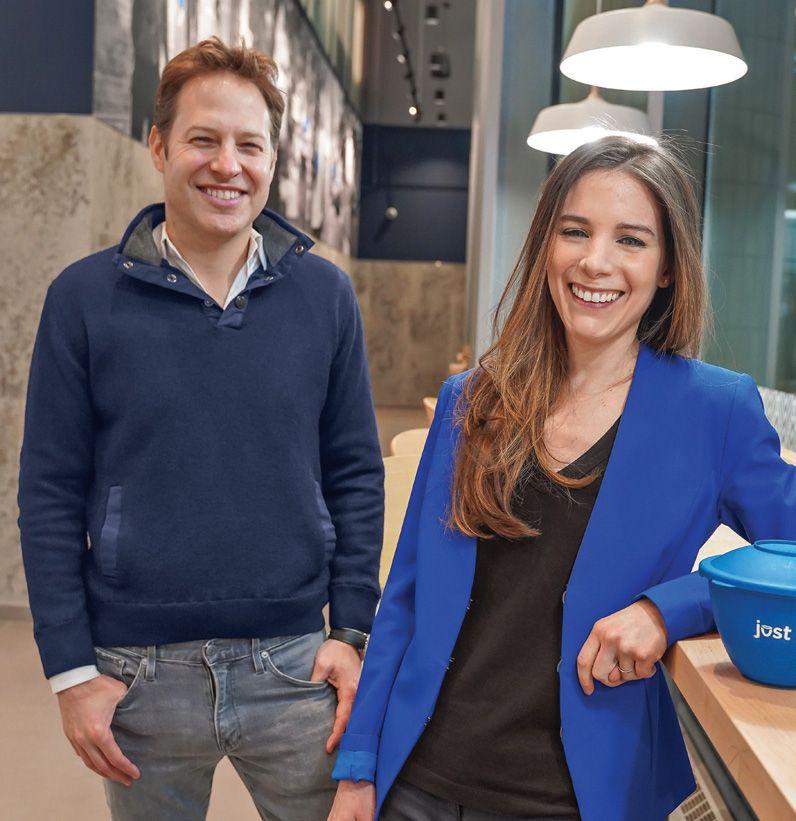



EDITORIAL
EDITORIAL DIRECTOR, FOOD NEWS MEDIA: Danny Klein danny@qsrmagazine.com
MANAGING EDITOR, FOOD NEWS MEDIA: Nicole Duncan nicole@qsrmagazine.com
DIRECTOR OF CUSTOM CONTENT: Peggy Carouthers peggy@qsrmagazine.com
CUSTOM CONTENT ASSOCIATE EDITOR: Charlie Pogacar charlie@qsrmagazine.com
CUSTOM CONTENT ASSOCIATE EDITOR: Kara Phelps kara@qsrmagazine.com
CONTENT EDITOR: Ben Coley ben@qsrmagazine.com
STAFF WRITER: Trevor Griner Trevor@qsrmagazine.com

ART & PRODUCTION
ART DIRECTOR: Tory Bartelt tory@qsrmagazine.com
ONLINE ART DIRECTOR: Kathryn “Rosie” Rosenbrock rosie@qsrmagazine.com
GRAPHIC DESIGNER: Erica Naftolowitz erica@qsrmagazine.com
PRODUCTION MANAGER: Mitch Avery mitch@qsrmagazine.com
ADVERTISING

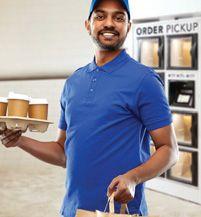
800.662.4834
NATIONAL SALES DIRECTOR // EXTENSION 126 : Eugene Drezner eugene@foodnewsmedia.com







NATIONAL SALES MANAGER // EXTENSION 149 : Edward Richards edward@foodnewsmedia.com
NATIONAL SALES MANAGER // EXTENSION 141 : Amber Dobsovic amber@foodnewsmedia.com
NATIONAL SALES MANAGER // EXTENSION 148 : John Krueger john@foodnewsmedia.com
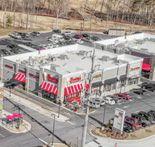
SALES SUPPORT // EXTENSION 124 : Tracy Doubts tracy@foodnewsmedia.com
CIRCULATION WWW.QSRMAGAZINE.COM/SUBSCRIBE
CIRCULATION COORDINATOR: N. Weber circasst@qsrmagazine.com

ADMINISTRATION
GROUP PUBLISHER, FOOD NEWS MEDIA: Greg Sanders greg@foodnewsmedia.com
PRESIDENT: Webb C. Howell
MANAGER, IT SERVICES: Jason Purdy
ACCOUNTING ASSOCIATE: Carole Ogan
ADMINISTRATION
800.662.4834, www.qsrmagazine.com/subscribe
QSR is provided without charge upon request to individuals residing in the U.S. meeting subscription criteria as set forth by the publisher.
REPRINTS THE YGS GROUP TOLL FREE: 800.290.5460
FAX: 717.825.2150
E-MAIL: qsrmagazine@theygsgroup.com www.qsrmagazine.com/reprints
Sponsored content in this magazine is provided by the represented company for a fee. Such content is written to be informational and non-promotional. Comments welcomed. Direct to sponsoredcontent@foodnewsmedia.com


As we were planning our 2022 calendar, the notion of a climate issue gave me some pause, I have to admit. Not that I’m not a believer in the topic, but I just wasn’t sure where to go with it. In some ways, it reminded me of diversity and a conversation my colleague Ben Coley and I had with Dr. James Pogue a few months back. James is the president and CEO of JP Enterprises, a company that helps coach inclusivity at the leadership and team level. One of their banner phrases is, “The Right Kind of Uncomfortable.” We talked about that framework and the role of media in all of it. How it often can feel forced or fake, and in turn, sail the intended impact. So, in the end, you’re left trying to further a message and yet do it for the right reasons. It’s a complex line.
My initial response to a magazine dedicated to climate and the industry’s role in it was, “what can we at QSR bring to the table that hasn’t been talked about already?” My boss’ answer was simple: We need to stir the conversation. You can’t expect or promote change without giving a voice to it. And that’s really where I began. Who were the thought leaders and innovators in this space, from the back ( page 36 ) to the front ( page 28 ) of it. I asked Just Salad chief sustainability officer Sandra Noonan what mattered to her. And what was going to matter next year ( page 20 ). Throughout our conversation, from the circular economy to food waste, the notion of leading from an uncomfortable position kept surfacing. Namely, I floated a pretty common theme in her direction—“are customers asking for this?” Noonan’s answer wasn’t what I expected and she quickly dispelled it. While the
answer has hints of “yes” in it, and you can read stats to back that up all over Google, the larger implication and directive is that it doesn’t matter.
Whether or not surveys and random polls return that point, Just Salad was going to invest, and invest heavy, in sustainability and climate-centric initiatives. On the topic of reusables, for instance, Noonan put it this way: “It’s a matter of operators’ ability and willingness to participate; it’s a matter of policy; and it’s a matter of shifting public opinion. When those three reach a critical level, we will hit a tipping point.” But Just Salad isn’t waiting around.
Noonan admitted an inflection wasn’t quite in sight, which is why the company incentivizes climate-friendly behavior like some brands might a visit. Use a reusable bowl, get a free topping. On the brand’s app there’s a carbon label filter that recently allowed Just Salad to discount pricing for an Earth Day deal. The idea of rewards and loyalty evolving into sustainability programs is something Noonan says the brand is headed toward, and she thinks others should, too.
“To be clear, we don’t come in every day and say the customer wants more sustainability from us,” Noonan said. “We come in every day and we say we’re doing sustainability. And brands need to lead.”
Dressed down, it’s the message I was given to make this issue happen. While we might not all be eager or ready to take sustainability steps or have debates, the answer isn’t to shelve it for further review.

 Danny Klein, Editorial Director
Danny Klein, Editorial Director







It’s not a topic every restaurant is comfortable talking about, but that might just be the point.



CHEF MANISH TYAGI BELIEVES WHOLESOME , SUSTAINABLE CALIFORNIA DAIRY INGREDIENTS Y MAKE HIS SIGNATURE INDIAN FUSION DISH THAT MUCH MORE COMPELLING.

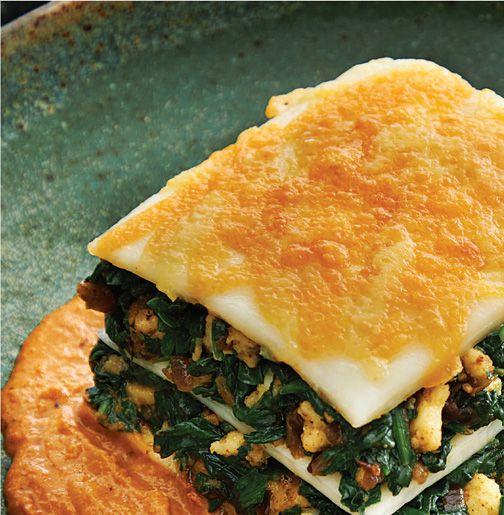
CHEF MANISH TYAGI has a lways done things his own way. That was never more evident t han when , in t he midst of the pandemic, he opened his restaurant , Aurum , in Los Altos , California. It was a risky move, coming at a time when more independent f ullservice restaurants were shutterin g rather than opening.
But Aurum has been a smash h it in t he Bay Area, t han k s in large part to T yagi’s innovative takes on traditiona l Ind ian d ishes. Tyagi’s artistr y is on full display in Aurum’s best-selling d ish : a spinach and paneer past a dubbed “I’m Not Pasta.” The entreé uses thinly-sliced Real California paneer cheese to mimic lasagne noodles, sandwiched around a fi lling of brown garlic, fenu g reek leaves, and California
mozzarella. The lasagne-like creation is cooked and then plated atop a spicy tomato sauce and fi ni shed wit h ba sil oi l and ch i l i t h read s.








“At any Indian restaurant, you’ll fi nd a paneer d ish ,” Tyagi says. “But I don’t do any Indian dish the way you’d fi nd it in a tra d itiona l Ind ian restaurant. I add my own st yle to it. It’s a ver y old culture and cuisine, but there’s always room to present it as a new version. So when somebody sees ‘I’m Not Pasta’ on the menu, there’s a sur prise element to it , but the color, texture, and taste of the dish speak for themselves.”
T he R EAL Ma kers video series spotlights chefs using California dair y







he bel ieves it’s a h ig her qua l it y product than chefs can fi nd elsewhere He also believes in sustainable practices , alsobelievesinsustainablepractices a nd, accordin g to the California Milk Advisor y Board, California farmers

a re more than halfway to a statewide goal of 40 percent less methane emissions by 2030. The California dair y industry’s carbon footprint has shrunk
4 5 percent over the past 5 decades, and about 40 percent of a Cali fornia dair y cow’s diet consists of by products from food and fiber production—like almond hu ll s and grape pomace—keepin g

t hese by products out of landfi lls and reducin g the amount of water needed

to grow additional feed by around 1.3

t rillion gallons per year.
For t hese reasons, Tyagi rel ies on Real California Cheese and trusts that it performs as well or better than anyt hin g a restaurant could make in house.
“ I like California dairy for both its consistenc y and taste,” T yagi says. “And because it’s f rom here, the taste is California.”
BY CHARLIE POGACARFor more, visit realcaliforniamilk.com/foodservice

I FOUNDED THE BLACK FoOD COlLECTIVE TO BRING LIGHT TO SMAlL BUSINEsSES AND HELP THEM GROW.
InNOVATION BUbBLES UP AT CHEF RASHAD ARMSTEAD’S OAKLAND GHOST KITCHEN.
WE’RE “DELIVERYONLY,” SO FLAVOR IS EVEN MORE IMPORTANT, AND CALIFORNIA CHeESES MAKE MY FoOD TASTE THAT MUCH BEtTER.
I USE FIVE OF MY FAVORITES IN THIS JAMBALAYA MAC & CHeESE!

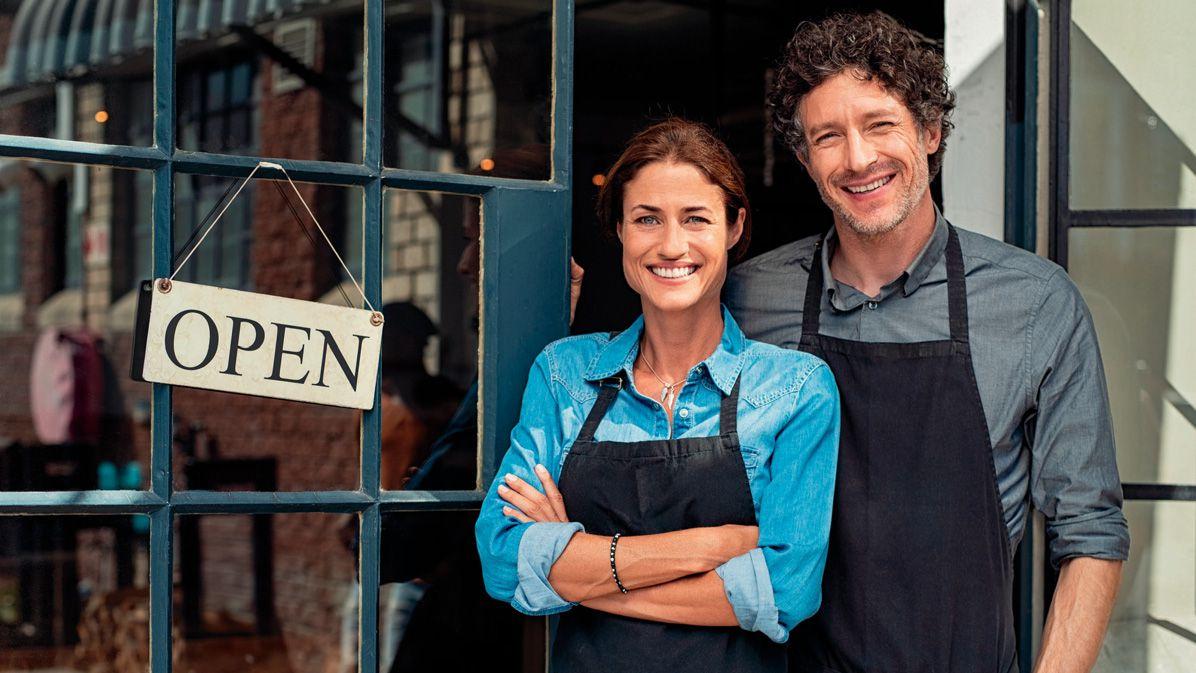
Domino’s (and its marketing materials) found a home in this past season of “Stranger Things.”



Domino’s created an immersive ordering experience for guests that was out of this world.
MIND-ORDERED PIZZA? Domino’s made this otherworldy notion a reality in May around the premiere of “Stranger Things’” new season. The brand’s “mind-ordering app” placed test subjects inside Hawkins National Lab in Hawkins, Indiana, transporting them to the center of the show, circa 1986. Users could explore the lab, uncover Easter eggs, use telekinetic powers to gain control of certain objects, and place a Domino’s Easy Order. The chain deployed facial recognition and eye-tracking technology so guests could use their “powers” to order pizza by making certain facial expressions and head movements.
“We’re geeked to launch this first-of-its-kind mind ordering app, just in time for the premiere of ‘Stranger Things’ new season,” says Kate Trumbull, Domino’s senior vice president of brand and product innovation. “Now hungry customers and ‘Stranger Things’ fans across the U.S. will get a taste of what it’s like to be Eleven, and they may find some hidden surprises along the way, such as the Noid or Demogorgon.”
SHORT ORDER
Food waste can fast become a convoluted debate. There are enough statistics and survey points to bury even the most informed operator. So we’ve cut through some of the noise to bring you a collection worth highlighting.
Ahalf a pound of food is wasted per meal in restaurants, whether it’s from what is left on a customer’s plate, or in the kitchen itself (GreenBlue).
U.S. restaurants generate an estimated 22–33 billion pounds of food waste each year. About 4–10 percent of food purchased by restaurants is wasted before reaching the consumer (NRDC)
WHERE OUR WASTE COMES FROM:
HOMES
43%



U.S. food waste is responsible for the equivalent of the emissions of 37 million, or one in seven, cars (Natural Resources Defense Council)
Roughly 85 percent of the food that isn’t used in a typical restaurant is thrown out. With more than 42 million food insecure people in our country, there’s no mystery why this is a problem (GreenBlue) reducing food waste by 15 percent could provide enough sustenance to feed more than 25 million people, annually (USDA)
America wastes roughly 40 percent of its food (NRDC)
While the world wastes about 1.4 billion tons of food every year, the U.S. discards more food than any other country in the world: nearly 80 billion pounds every year (EPA) That equates to 219 pounds of waste per person.
RESTAURANTS, GROCERS, FOODSERVICE COMPANIES (Feeding America)
MANUFACTURERS
The restaurant industry loses $162 billion annually thanks to wasted food (USDA).
55%
2% 16% 40% 40% 85%
On average, diners leave 17 percent of their meals uneaten and 55 percent of edible leftovers are left at the restaurant (Cornell University Food and Brand Lab)
The biggest concerns for most restaurants when it comes to food donations (41 percent of respondents in a ChefHero survey) are liability and transportation
TRASH BIN WITH FOOD WASTE: ADOBE STOCK LIGHTFIELD STUDIOS, FOOD SCALE: ADOBE STOCK DESIGNER, VEGETABLES IN BOWL: ADOBE STOC K BY PRIYANKA, CAR: ADOBE STOCK RASHADALIYEV, FOOD WASTE: ADOBE STOCK BY PRIYANKA, MAP OF USA: ADOBE STOCK BY HL, TRAS H BIN ICON: ADOBE STOCK BY JANIS ABOLINS, PAN: ADOBE STOCK BY MISSBOBBIT, HOME: ADOBE STOCK SATHAPORN, STORE: ADOBE STOCK TELMANBAGIROV, BARN: ADOBE STOCK MARTIALRED, FACTORY: ADOBE STOCK / MARC, MONEY: ADOBE STOCK JACARTOON, SALAD: ADOBE STOCK PRIYANKA, FOO D DONATIONS: ADOBE STOCK BSD STUDIO, RISK LEVEL ICON: ADOBE STOCK LYSENKO.A, COURIER: ADOBE STOCK LEREMY 10 JULY2022 | QSR | www.qsrmagazine.com




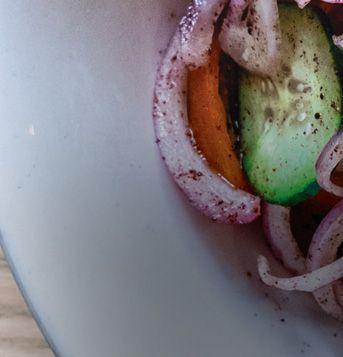 BY AMANDA BALTAZAR
BY AMANDA BALTAZAR
Just over a year ago, fast casual Kitava hired Preethi R as culinary director. One of her day one tasks? Reduce waste.
“Food waste is huge, and in a company it’s a cost,” says the culinary director. So as she worked on the menu, R looked at the yield of every ingredient and what the concept could get out of it—“truly get out of it,” she says.
Food waste is a growing problem, and food is the largest contributor to landfills, where it produces methane, a greenhouse gas even more potent than CO2. But many counter-service brands are taking every effort to curb the growing problem.

Kitava, a two-unit brand based in San Francisco, sells food

through ghost kitchens. Its cauliflower florets go into three different dishes—za’atar cauliflower and hummus; za’atar cauliflower (fried florets); and the mezze harvest bowl—and the stalk is shredded for cauliflower rice.
Avocados were proving to be a problem since they were inconsistent with brown spots, so R blitzes the problem areas into a sauce with lime and cilantro, and it’s added to the tacos and eliminated waste. As an added bonus, this boosts the nutrition of the tacos.
Kitava also takes care to use every part of herbs. Stems of softer herbs like parsley or cilantro go into a green goddess dressing;
heartier herbs are added to stock. This broth also contains chicken bones and leftover vegetable scraps—onion, carrot, celery—and cooks overnight, then is blended with ginger and turmeric.
R removed items from the menu, as well as added them. Shredded carrots in some of the bowl menu offerings added a nice earthiness but didn’t last long enough, so now the concept pickles them. “They last longer, they bring a great texture, feel, taste, and health benefit,” she points out.
Fat Choy, in New York City, is also as zerowaste as possible.
Chef and owner Justin Lee developed several menu items to reduce food waste through repurposing.
“At Fat Choy we put in the extra work to make the most out of every part of the plant,” Lee says. “So much goes into growing and transporting that plant, it seems wasteful to only use the most ‘desirable’ parts. Hopefully we can show people simple techniques they can easily adopt into their lives.”
Fat Choy is a vegan, “Chinese-ish” restaurant, through which Lee hopes to encourage people to eat less meat, while still being omnivores.

Lee had a lot of waste of stalks and leaves from his salt and pepper cauliflower. So he now cuts up the cauliflower cores very small and thin and fries them along with the florets. “By understanding they’re more fibrous we can fry them and increase our yield from that product,” Lee says. And he grinds up the leaves in the food processor along with stems from collard greens and uses them in sticky rice dumplings.
Mushrooms also have more than one use. Lee uses the caps of king oyster mushrooms in specials such as “Fun Guy Stew” and “Fun Guy Salad,” but can’t include the woody stalk. Instead, he braises and purees them and they add flavor to sauces, along with acting as a thickening agent. This goes into both dishes as well as soups such as stone soup, and hot and sour soup
And in perhaps the most innovative idea, Lee is confit-ing ginger skins and scallion roots then blending them into a paste. “We use that to flavor fried rice or to start up a braise or a soup, so that’s a really useful technique,” Lee says. Other scraps go into stock or flavored vinegars. He steeps jalapeño cores and seeds—or whatever he has on hand—in vinegar than uses it to make a house hot sauce. “It changes slightly in flavor depending on the season and what scraps we put into it,” he says.
Lee enjoys the task. “This is a different challenge—to make scraps taste good. The first step is to put everything into a stock, but we’re taking further steps and making that into solid food,” he says.
What is tricky is knowing how much of this to share with customers and do it in a non-preachy way. Lee is aware using food scraps might encourage some guests to come back and might deter others. “Every now and then on Instagram we might talk about it. The idea behind Fat Choy is this menu can exist anywhere in the world,” he says.
Shouk is an Israeli street food fast casual with three locations in Washington, D.C., and one in Bethesda, Maryland.


“We run at little to no waste,” says cofounder and CEO Ran Nussbächer.

He achieves this by having a very limited set of SKUs and using them to create as many menu items as possible. “We’re fairly aggressive in keeping it tight,” he says. “We’re always asking ourselves what more we can do with what we have. We try not to bring in anything that’s single-use because if it’s a perishable item and I’ve ordered too much of it I can’t use it for anything else. If I have two or three items with the same perishable item I’m unlikely to run into that problem.”
Oyster mushrooms, for example, are used in two very different ways and customers don’t even realize they’re the same, he says. The mushrooms are seasoned and grilled for mushroom schawarma; and breaded and deep fried for fried schouk’n. “The profile of the dishes couldn’t be any different,” Nussbächer explains. “That way we are able to have the flexibility to use the product for both without any leftovers.”
Likewise with chickpeas, which are used in hummus, falafel, and the Shouk veggie burger. “They all taste different and feel different. We have a fairly limited set of SKUs and we’re fairly aggressive in keeping it tight.”
Shouk’s menu is 100 percent plant-based, which means, Nussbächer says, “that our products aren’t as perishable as animal proteins. We have more time on items; a tomato doesn’t go bad as quickly as a steak and if goes beyond 24 hours that’s OK.”
Nussbächer also enjoys the challenge of being as zero-waste as possible. “It’s good for the planet, good for business,” he says. q
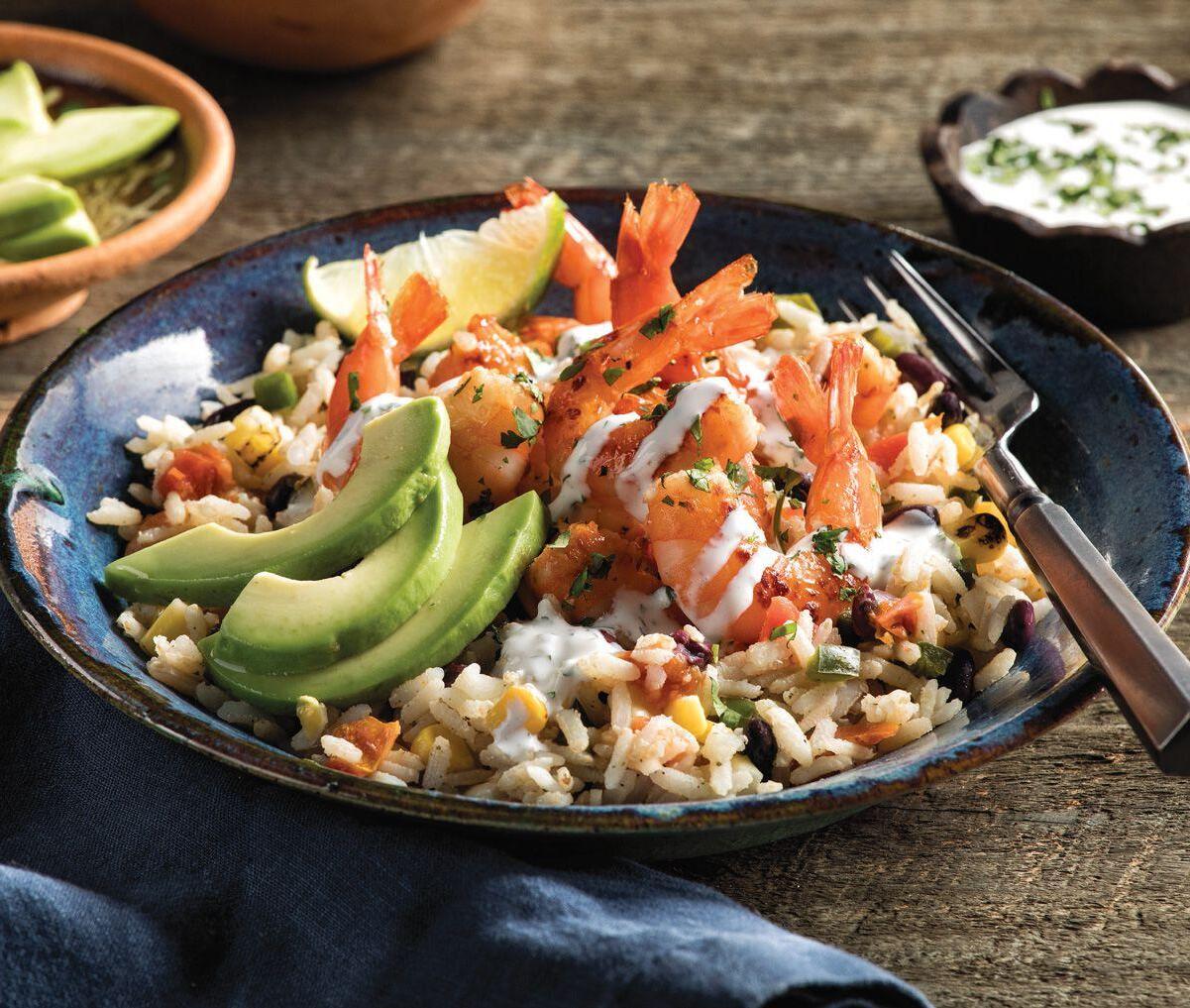









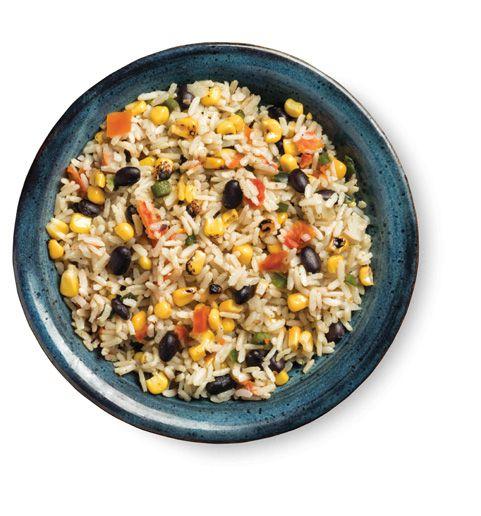

Both a commercial real estate broker and a longtime restaurant operator, Josh McBride is better equipped than most with insights into the quick-service site selection process. And, as the industry evolves at a rapid pace, there’s been no better time to revisit some of the fundamental calculations that should be on every operator’s mind when looking for real estate.
Below is an edited version of a conversation between McBride and QSRmagazine.
What is your background in the restaurant and real estate industries?
“I began my restaurant career with Chickfil-A in 2004, where I served for over 9 years, including as an owner-operator. I also spent time as vice president of development for what was, at the time, the largest Pieology Pizzeria franchisee group. More recently, I co-founded Hogwood BBQ in Franklin, Tennessee—one of the highest-rated BBQ restaurants in the Nashville area.
Since launching McBride Real Estate a few years ago, I’ve brokered over $50 million in


perform for the dinner or weekend business. Operators should ideally look for sites with high counts for both categories.”
retail and restaurant leases across the Southeastern U.S., and have evaluated over 1,000 raw land development opportunities, resulting in a net lease asset sale value of over $75 million”

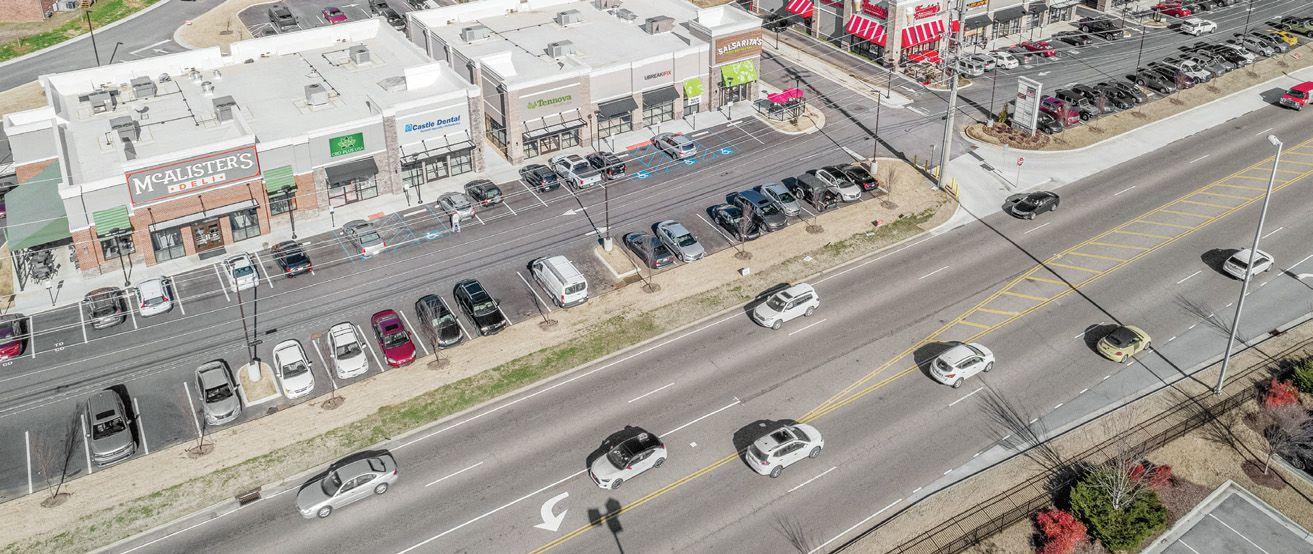
What are key things franchisees and operators should look for when targeting sites?
“When analyzing an opportunity, there is nothing more critical to understand than how the restaurants in the immediate vicinity are performing. There are some very sophisticated software programs today that can provide operators with real-time customer traffic data that wasn’t accessible 5 years ago. Operators should use these tools to understand how their competitors are performing at a specific location and then target the sites with the highest probability for success.
Employee population in a trade area typically correlates to how the restaurant should perform in the breakfast and lunch dayparts. Residential population in the trade area typically correlates to how the restaurant should
What are key things franchisees and operators should inquire into when negotiating commercial real estate?
“Aside from rent, a big concern for most restaurant operators is their initial cash investment in the space. Borrowing is getting more expensive while, at the same time, construction costs continue to rise. A secondgeneration restaurant space can be a very good option, if you can find one.
For new developments, the operator can submit a work letter to the landlord. This work letter could include stipulations like having a grease trap, patio with railing, upgraded electrical panel, and high tonnage HVAC installed. Most franchisors should be able to provide a detailed landlord work letter for their brand.
Rent and investment are the two most critical items in the landlord proforma as well, so compromise is key. Operators should expect to pay a premium in rent if the landlord is prepared to invest additional capital in their restaurant buildout.”

At a time with little margin for error, an expert shares insights on targeting the right locations. /BY CHARLIE POGACAR






In the 10 years since, Cousins Maine Lobster has grown to roughly 40 food trucks nationwide and a handful of restaurants, from Maine and Massachusetts to California and Nevada.

While the concept is still relatively young, the regulations it abides by to obtain product are more than 100 years old, says Annie Tselikis, who leads marketing and franchisee engagement. She refers to the Maine lobster business as the “gold standard in sustainability.”
“This industry has been sustainable since before the word was ever a buzzword,” says Annie Tselikis, a 15-year veteran of the Maine lobster industry.
There are roughly 4,500 licensed lobster fishermen in Maine, and the entry/ exit procedures are strict. If one wanted to start fishing tomorrow, they would have to undergo a two-year apprentice program with a licensed fisherman, the majority of which would be documented fishing time on the water, in addition to gear work and learning navigation.


FOUNDERS: Jim Tselikis and Sabin Lomac
HEADQUARTERS: Portland, Maine
YEAR STARTED: 2012
ANNUAL SALES: $54,757,000 (in 2021)
TOTAL UNITS: 36 trucks and seven brick and mortar restaurants
FRANCHISED UNITS: 38 Franchised units total
COUSINS JIM TSELIKIS AND SABIN LOMAC SPENT much of their formative years—weekends, summers, and holiday breaks—hanging out with family members and enjoying lobster, a staple in the state of Maine.
The two went their separate ways in college, but reconnected years later in Los Angeles. They instantly fell into old habits
and were reminded of all those great times they had as kids. But it was more than just reminiscing; the passion for Maine and its lobsters ran deep, and the cousins felt there was opportunity to spread that familial love to the rest of the country.
In 2012, the idea ballooned into a Cousins Maine Lobster food truck in L.A., and not too long after, they found themselves being courted by ABC’s Shark Tank.
“We said no twice, and then eventually, an executive producer called and said, ‘you guys will be making the worst decision of your lives if you don’t do this,’” Jim Tselikis recalls. “So about 2.5 months into business, we were on the set of Shark Tank . We had targeted Barbara [Corcoran], believe it or not, and that is who we eventually did our deal with.”
After that, they would be eligible for a lobster license, but they would likely sit on a waitlist in most parts of the state for at least 10 years. That’s because the Maine Department of Marine Resources, which manages the fishery, will not let new fishermen into the industry until some come out. And usually, those licenses aren’t given up until someone is in a nursing home or passes away.
“I have friends that have sat on the waitlist for 10 years,” Annie Tselikis says. “That is a big deal.”
Once a person is in the fishery, they start with 300 traps and can add 100 each year until the 800 maximum. In terms of actual lobster, the industry is intently focused on maintaining the next generation. For instance, fishermen return egg-bearing females to the water and
From Shark Tank to a nationwide fleet of food trucks, sustainability has always been at the heart of the growing fast casual.



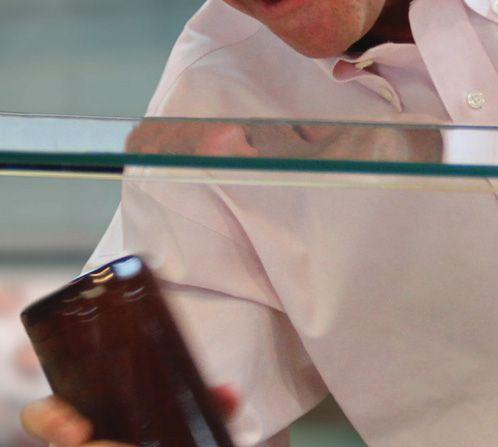







In the company’s report, it noted it had removed artificial colors and sweeteners from food. Moore says the company is dedicated to providing guests with high-quality, fresh, and delicious products, and the decision to remove artificial colors and sweeteners emerged a decade ago “to ensure our menu delivered guests the highest-quality food possible with only the best ingredients.”
The drinking straw initiative was first considered by Noodles back in 2021. “We are constantly looking at all elements of our business, and the conversation around compostable straws came up about a year ago,” Moore says. “Before implementing the new straw, we tested it to ensure it would uphold our high standards and we were pleased with the quality and our guests’ reactions.”
With climate concerns weighing more and more on consumers’ minds today, Colorado-based Noodles & Company decided to generate its first impact report, which was released in October. As the company notes, the report outlined the initiatives taken “in the areas of food, people, planet, and community” to improve the world and offer environmentally sustainable solutions to the fast casual’s business model.
One way it will affect change is through disposable paper drinking straws, and more green-conscious updates are also happening across Noodles’ more than 450 locations nationwide.
“As a values-led company, we believe in transparency, and it is important to us to share our journey as well as our path forward,” says Danielle Moore, director of communications. “Our first report served as a baseline to show what we’ve accomplished over the past 25-plus years and where opportunities lie moving forward. As a female, I was especially proud to see that females comprise 56 percent of our operations team and 50 percent of our executive team, and I am continually proud of Noodles’ dedication to inclusion and diversity.”
Last fall, Noodles announced a partnership with Hoffmaster Group Inc., a 66-year-old company known for specialty disposable tabletop products in brands like Linen-Like, FashnPoint, and CaterWrap. Its brand of Aardvark Straws are certified BPI-compostable, FDAapproved, naturally degradable, and made in the U.S. Martin Stone’s original patent on paper straws dates back to 1888, and the straws were re-introduced into the marketplace back in 2007 when Aardvark saw a growing need because of the anti-plastic movement that included restaurants, hospitals, and other service industries. Indiana-based Precision Products Group Inc. was asked by Aardvark to create a straw that was more environmentally friendly. Hoffmaster purchased Aardvark in 2018.

“[ Hoffmaster] is a leader in developing environmentally friendly products, and we were very impressed with the quality of their straws and the other products they offer,” Moore says. As reported this past January, this change will remove nearly 21,000 pounds of plastic from the company’s waste stream annually.
Last year also found Noodles developing a fresh plan to reduce water and energy usage. The company began installing a new dripper system chain-wide that Moore says reduces water usage by more than 30 percent. The dipper wells Noodles recently installed have restricted waterflows, which will improve the amount of water usage into each location using them. The company is also exploring new high-efficiency faucets it hopes to bring to
With custom programming, one-touch operation and precision performance, Vitamix® machines empower employees to achieve perfectly consistent results every time – even the first time.

It’s just one reason we’re the industry’s most trusted blending partner.
See what else sets us apart at VITAMIX.COM/OURDIFFERENCE




Sandra Noonan doesn’t typically cold email CEOs. But she recognized something about Just Salad the company itself likely didn’t. In the emerging conversation on circularity, the New York City-based salad chain was a decade ahead.

This was 2019, about 13 years from when Nick Kenner and childhood friend Rob Crespi debuted the brand as a way to serve healthy, quick food in a market that lacked accessibility. The goal, as Kenner said then, to become the “Trader Joe’s of fast food,” or a restaurant where organic on the menu didn’t signal breaking the bank.
A year earlier, Noonan read an article in the New Yorker on the Great Pacific Garbage Patch (the largest of five offshore plastic accumulation zones in the world’s oceans) and was disgusted. She took one statistic, in particular, to mind—a finding in Science Magazine that claimed 275 million metric tons of plastic waste was generated across 192 coastal countries. “I had a, ‘I did not sign up for this moment’ as a consumer,” Noonan says. “And started doing more research and learned that only 9 percent of all plastic has ever been recycled, according to scientific literature.”
It made her think of Just Salad. In addition to Kenner’s aim to bulldoze barriers to healthy food, he devised a reusable container prototype in hopes of limiting the plastic salad vessels stuffing waste baskets throughout the city.
Kenner and Just Salad execs oversaw the program, yet they also were trying to run a growing restaurant chain that had scaled to about 40 stores (there are 60 today). Naturally, one often preceded the other.
Just Salad’s Sandra Noonan is proof one fast casual is taking environmental issues to heart. But she’s ready to start a broader
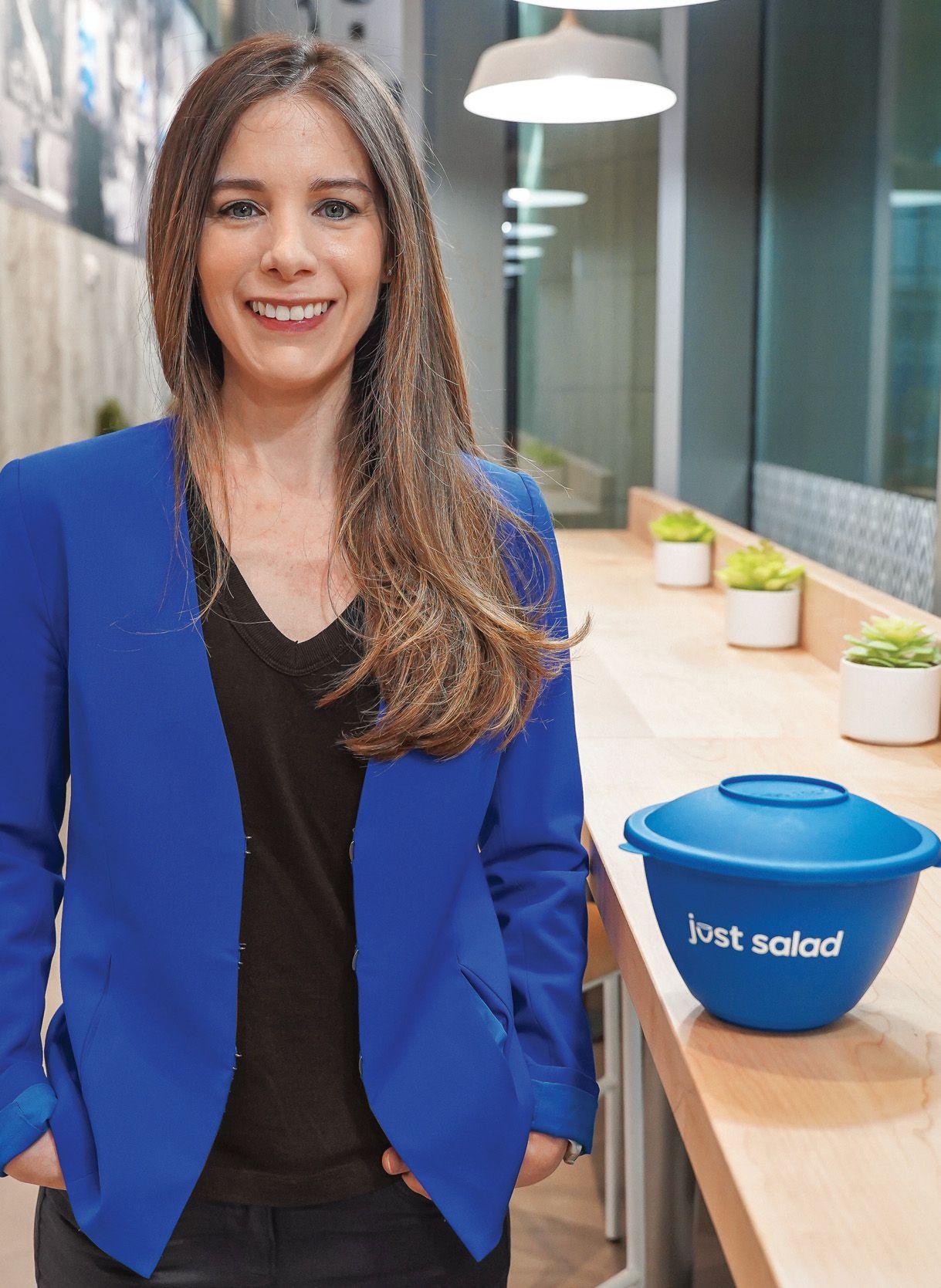

Earlier in her career, Noonan served as VP of digital strategy at Morgan Stanley’s Institute for Sustainable Investing. She also worked as a reporter with Bloomberg, independent marketing consultant, and adjunct instructor at NYU’s School of Professional Studies. But when she came upon Just Salad’s reusable bowl, Noonan was spending all of her free time on an advocacy group she founded in 2019 called Zero Waste NYC, which had grown to a few hundred members.
“He answered within a day,” Noonan says of her email.
Kenner told Noonan to come by and trade thoughts. So she slipped out of work one day and took the subway to Just Salad’s Manhattan HQ. “I didn’t really know what I was doing there,” she says. “But I said listen, I am really passionate about this reusable bowl program … I realized that he was totally engrossed in what I was saying.” A few months later, Kenner asked Noonan to join in. She accepted on the spot, which is how the fast casual became one of the few ( it’s challenging to find any ) restaurant brands in America to employ a chief sustainability officer in its C-suite.
What Noonan wanted to accomplish from the outset was increase the cultural relevance of reusables—to tell Just Salad’s story and how it all connects with a broader dilemma. In a 2021 report by United Nations Environment Programme, an estimated 931 million tons of food waste was generated in 2019, globally. The U.S. throws away more than any other country in the world, with nearly 80 billion pounds of food wasted per year, an estimated 30-40 percent of the country’s entire food supply.
Nearly 9 million tons of single-use food service items are used every year, too, equivalent to the weight of 25 Empire State Buildings.
Circling the restaurant sector, per the USDA, the industry loses $162 billion annually thanks to wasted food.
Right away, Kenner asked Noonan to help Just Salad along many of these fronts, starting with composting. And it’s only gained over the years. Eco-labeling; a Sustainability Champion program for in-store staff; becoming the first U.S. chain to display carbon labels on its menu.
Before exploring some of Just Salad’s nuanced directives, it’s worth pulling back.
Noonan says the chain, and restaurants as a whole, are only scratching the surface on storytelling when it comes to climate. It’s taken years, but the ceiling is nowhere in sight.
Still, the juncture at hand holds promise. One reason being sustainability, reusables, and other environmental top-
ics got buried over the past couple of years by COVID-19. Just for restaurants, the rush to serve off-premises guests—often with single-use plastics—raced ahead on the priority chart. But similar to how consumers tapped comfort food early and have begun to return to health-minded goals, the same is true of watching their environmental impact, Noonan says.
A study from Unilever showed 72 percent of U.S. diners care about how restaurants handle food waste. Forty-seven percent added they’d spend more at restaurants with an active food recovery program.
While that might be anecdotal in scope, Noonan says hard data is where change is really beginning to unfold. It’s central to sustainability communication with customers, she adds, almost to the point where calling this directive “storytelling” doesn’t fit anymore. “It might imply spinning a story,” Noonan says. “That’s not what we’re talking about at Just Salad.”
In 2021, as part of an internal audit guided by SASB (Sustainable Accounting Standards Board) standards, Just Salad estimated 91 percent of its disposable food service packaging was made from recycled and/or renewable materials, and 90 percent of its packaging was recyclable, reusable, and/or compostable. In an effort to provide multiple ways for customers to access reusable packaging solutions, Just Salad expanded its partnership with Deliver Zero to offer reusable containers for pickup and delivery orders on DoorDash and Caviar. Through Deliver Zero, customers can choose to have their order built in a reusable DeliverZero container. Then, they can return it to the Just Salad location they ordered from or any store within the DeliverZero network.
Here’s an example: It took Just Salad roughly a year to run a third-party environmental impact assessment with the New York State Pollution Prevention Institute at the Rochester Institute of Technology to measure its reusable bowl benefits compared to disposable containers. The goal being to capture the “break-even point,” or number of times the bowl must be used for its impact to be less than fiber disposable bowls. To do so, the LCA evaluated the carbon emissions and water use associated with each bowl at each stage of its life cycle.
The LCA showed, on average, Just Salad’s reusable bowl resulted in lower global warming ( greenhouse gas emissions ) and water consumption impacts than disposable fiber bowls after two uses.
Alter three, the global warming impact was equivalent to 42 percent of the impact of the fiber bowl. Four in and it dropped to 34 percent. With water consumption, the impact after three uses measured to 55 percent that of the fiber bowl, while after four, it fell to 46 percent, on average.
Perhaps the most concise and repeatable way to explain it—and share with guests—is a customer who washes and reuses their bowl once per week for an entire year could create 89 percent fewer greenhouse gas emissions and use 78 percent less water, on average, compared to the same number of uses of disposable fiber bowls, according to calculations published in Just Salad’s impact report.

NEXEO takes communication beyond the drive-thru and into key areas of your restaurant, increases efficiency with voice commands and one-to-one conversations, and seamlessly supports Automated Order Taking. And that’s just the beginning.





















It was a painstaking, lengthy effort, Noonan says. Yet invaluable. Just Salad has offered reusable bowls since the opening of its first location, making it home to one of the longest running programs in the U.S. restaurant industry. How could the brand turn a trait into a movement?
Over the years, Just Salad’s “MyBowl” guests purchase the signature blue bowl for $1, and the chain gives them a free topping each time they use it.





The impact last year measured at more than 3 tons of single-use plastic bowl waste avoided. Keeping to a Big Apple theme, you could have stacked enough single-use plastic bowls to create a tower 15 times taller than the Empire State Building.




Also, amid the pandemic, Just Salad launched a pilot program at a Murray Hill store that offered guests a way to access reusable bowls for online pickup orders. Just Salad’s “BringBack” platform enabled customers to receive their online salads in a green reusable bowl and return it to a restaurant, where Just Salad employees took care of the washing. The brand expanded the platform to Midtown and initial analysis found BringBack users ordered from stores twice as frequently per week versus non-BringBack guests. As this scales, Just Salad plans to make it available on the company’s mobile app.
The data story, however, continues to thread throughout. Not just in Just Salad’s decision-making, but also in the way it’s courting customer frequency.
Leaders met with Anna Keller, a PhD candidate in environmental psychology at the University of Central Lancashire, who has published research on the various stages of behavior change during an individual’s transition from single-use to reusable cups, to tap her methodology. Just Salad then surveyed customers and found 65 percent were interested in using fewer single-use containers, yet either have not started reducing, did not know how, or didn’t think it was possible.
BRING YOUR OWN CUP: Last year, Just Salad relaunched its Bring Your Own Cup (BYOC) program for smoothie orders, giving customers the choice to avoid single-use paper cups.


SINGLE-USE UTENSIL OPT-OUT: On the Just Salad app and orderjustsalad.com, customers are asked to indicate yes or no for disposable utensils. Just Salad offers a 10-cent discount on delivery orders that optout of utensils. In 2021, the utensil opt-out feature on orderjustsalad. com avoided over 2,200 pounds of unnecessary waste.
DINE-IN BOWLS: Often in fast casual, customers receive their orders in disposable packaging even if they plan to dine on-site. Just Salad continues to introduce dine-in bowls at locations with sufficient seating capacity.

Just Salad also enlisted the help of eco-rapper and content creator, Hila the Killa, to leverage influencer marketing.



To put it plainly, Just Salad is spreading its message with more ammo than ever. “Data is the foundation of good story telling,” Noonan says. “And I think before Just Salad had a CSO, it didn’t have the bandwidth or resources to do that. …



I think the next two or so years at Just Salad we’re going to be able to talk about the benefits of reuse in a much more data-cen-










tric way.” Noonan does want to make one point clear, though—Just Salad doesn’t show up and say, “the customer wants more sustainability from us.” Although feedback and demand are always golden eggs to chase in hospitality, a topic like sustainability—akin to diversity—is one that idles if there’s no driving force. “We come in every day and we say, ‘we’re doing sustainability,’” she says. “And brands need to lead.”
This is a critical notion, Noonan adds, in understanding where restaurants go from here. Simply by having a CSO, Just Salad is sending a message that’s it’s going to try to skate ahead versus responding only when consumers ask for it.
However, there is an intersection. “For 16 years, we’ve had a very loyal cohort of consumers who have used the reusable bowl millions of times,” Noonan says.

Would Just Salad have witnessed this kind of activity and stability if not for the fact it gives free toppings away? The answer returns to Noonan’s point about the brand’s need to carry the sustainability banner on its own back.
The program owes some measure of its success, arguably a good deal of it, from the fact it offers an incentive to guests for doing something that’s not necessarily convenient.





But that’s not a negative spin, Noonan explains. Rather, it’s something she hopes more restaurants adopt. The pay-off is worth the price tag.

The company’s September 2020 call to introduce a seven-item “Climatarian Menu” that allowed customers to calculate greenhouse gas emissions with build-your-own salads, offers a blueprint. Come October, Panera Bread started doing something similar, although there were visible differences, like the unit of measurement Just Salad was using, kg CO2e. When guests ordered an item online at Just Salad, they saw the estimated carbon footprint compared to that of a quarter-pound beef patty, for context.
On the incentive note, the day Just Salad’s “Eat for the Earth” campaign launched, it changed the price of its Climatarian Menu items to reflect their individual carbon footprints. So a salad with a carbon footprint of 0.41 kg CO2e cost $4.10.
This year, any salad or warm bowl was $8.99 for customers








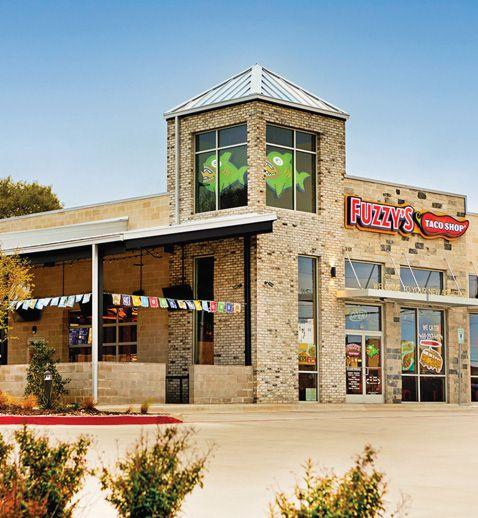


using reusable bowls. Online or via the app, if they filtered by Climatarian, guests found a selection of low carbon-emitting salads at that price point. Again, nudging consumers at a cost Just Salad is more than willing to write a check for.
Rewarding guests for eating on the low end of the carbon footprint scale almost surely will pop up again for Just Salad, Noonan says.
Logistically, Just Salad’s Climatarian dietary filter sits alongside vegan, keto, gluten-free, and paleo offerings, giving customers a shortcut to identifying the brand’s lowest-impact options. Fast Company named it one of 2021’s “Wor Changing Ideas.”
More recently, Just Salad’s carb o labels achieved compliance with inte national greenhouse gas (GHG) emission protocols ISO 14040/14044 and the Br i ish PAS 2050 standards.
The brand’s partner, Planet FWD, cal culates the carbon impact of the individu components of each salad, including bu not limited to, individual ingredients and packaging materials, which is where t h final emissions value comes from. Ju Salad calculates miles traveled by each ingredient based on their origin.
Noonan describes the overall arc as “cradle to grave,” meaning it starts from extraction of raw materials and ends at the end-of-life for all the inputs required to create a single unit of product.
REFORESTATION:
Just Salad funded the planting of 12,000-plus trees through Mastercard’s Priceless Planet Coalition.
ENERGY:

The company reduced average annual energy use by 7 percent, achieving reductions as high as 20 percent in some months, through a four-store pilot program with Budderfly.
REGENERATIVE AGRICULTURE:
Just Salad raised $15,000 to support regenerativeagricultureprojects
“On reusables, it’s a matter of operators’ ability and willingness to participate,” Noonan says. “It’s a matter of policy. And it’s a matter of shifting public opinion. When those three reach a critical level, we will hit a tipping point.”
One way to get there could be through one of the industry’s fastest-growing avenues—rewards. Relevant pre-virus but ignited by a landscape of mass digital adoption, restaurants are using loyalty and digital channels to accelerate data gathering and brand experience. Can these turn into sustainability outlets?
ANIMAL WELFARE: The fast casual met its goal of sourcing 100 percent of eggs from hens raised cage-free.


“That’s what we’re getting toward,” Noonan says. “Rewarding a customer for reusable bowl usage in our app is something we want to do, and we plan to. So I think that the industry has to get creative about integrating sustainability.”
And beyond the output and tangible efforts, Just Salad’s structure is one other chains can take heed of. The fast casual’s marketing and brand departments not only report to Kenner, they report to sustainability as well. It’s not a matter of sustainability reporting to marketing, which is more common, but rather vice versa. “That sets the tone for the organization,” Noonan says.
Noonan recalls having these conversations with Kenner in November 2019, just a few months into her role. Just Salad had cleared some early, pillar ideas, like composting, and were swapping thoughts on how to further talks about the relationship between food and environmental sustainability.
“During that conversation, we were like yeah, there’s been a lot of talk about eating locally. It’s wonderful. Should we be talking about that more?” Noonan says. “And I looked at the data and I was like, huh, it says that approximately 10 percent of a food’s carbon footprint is related to the miles it travels.”
The bulb flashed: Eating local wasn’t the end-all to achieving a low carbon footprint. And perhaps the nutrition label in general was a bit outdated. “Maybe now we need something that takes planetary health into account, too,” Noonan says.

Broadly, she hopes Just Salad is putting a dent in public awareness that consumers, as eaters, affect climate change. Noonan speaks with other quick-serves and CEOs about reusables, she says, and partners where the brand can. She adds there’s plenty of willingness industry-wide to get on board, but reusables “are a tough nut to crack for a lot of operations.”
It requires training, procedures, and it can’t flip on overnight.
The result is every marketing initiative gets scrutinized through the lens of sustainability. This runs up and down the ladder. Every time a new employee joins the company, HR sends an email introducing them and asks for a sustainability tip to share for their welcome.
Noonan believes greenhouse gas footprints, at the corporate level, is where the next topic is going. With the SEC proposing a new regulation that publicly traded companies vastly expand their climate disclosure, quantifying scope 1, 2, and 3 emissions is becoming table-stakes. Just Salad last year, for the first time, completed a greenhouse gas emissions inventory, conducted by the consultancy Green Places, across the entirety of its operations. The company also invested in store waste audits showing significant progress toward diverting more than 90 percent of daily waste from landfills, and started selling surplus food via Too Good to Go to achieve quantifiable reductions in wasterelated emissions.
“I think that a number of emerging companies will make it easier for small- to medium-sized restaurants to understand their carbon footprint and use data to surgically attack the areas that are most responsible for their environmental footprint,” Noonan says. “And that is generally your supply chain.”
“So we cannot lose sight of the big picture,” she adds. q


















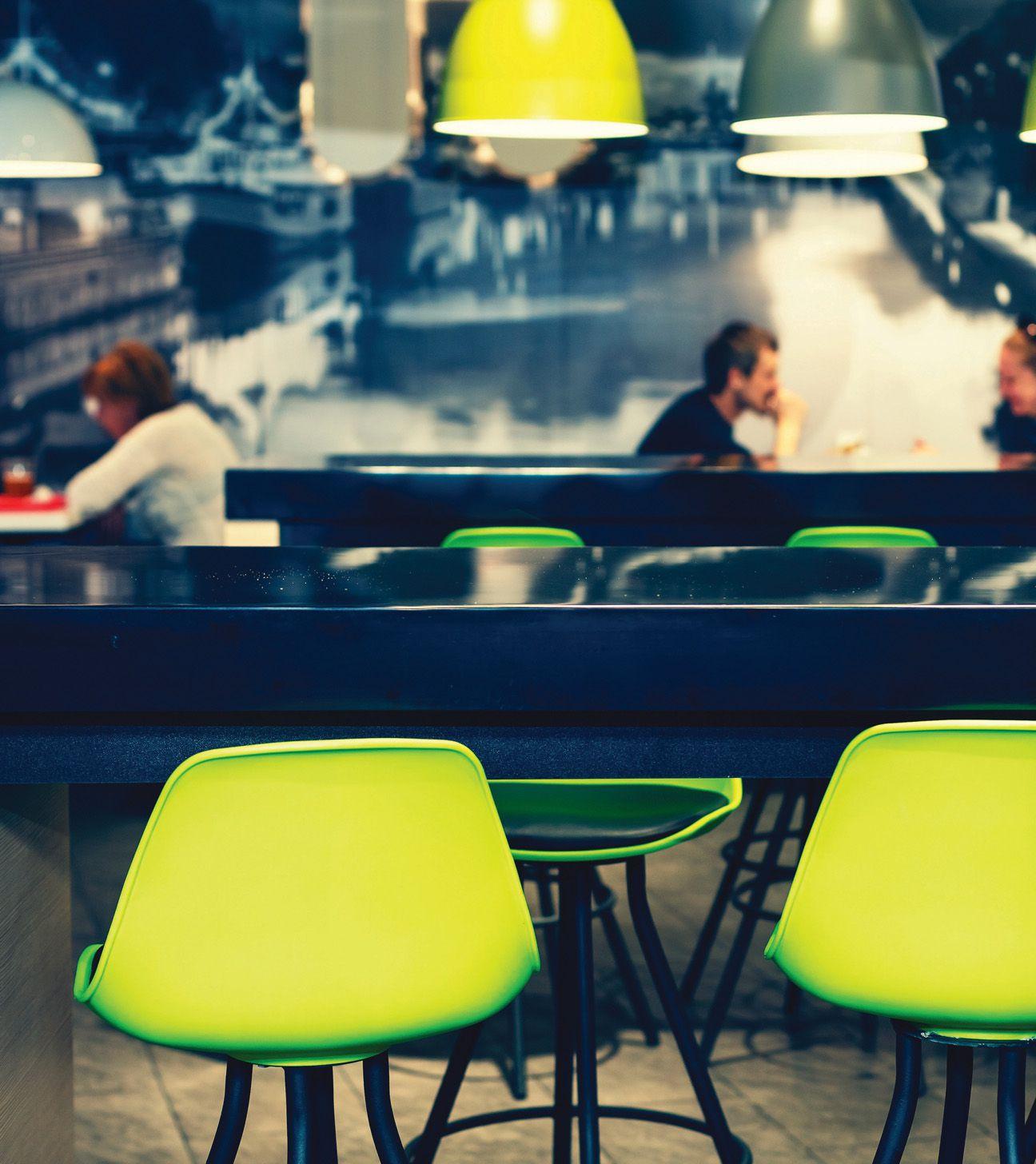
It’s not easy being green, but green is increasingly essential. In a 2021 survey of roughly 2,000 executives, two in three said environmental issues are “significantly important to them personally.”


In that same survey, conducted by the IBM Institute for Business Value (IBM-IBV), 39 percent of the organizations said environmental sustainability was already a top priority in their company and, within three years, 53 percent expect it will have become a top priority.
In the consumer-focused, labor-strapped restaurant industry, the significance of environmental sustainability is a driving force behind brand integrity, corporate responsibility, and bottom-line success. Becoming green-savvy and green-sincere is at the heart of attracting and retaining both consumers and employees.


Across 7,000 consumers surveyed this spring by Censuswide and Deliverect, 43 percent said they are willing to pay more at restaurants that have visible sustainability practices and more than half, 56 percent, would choose a restaurant that uses eco-friendly packaging and does not have singleuse plastic.
That said, more than half (again 56 percent) also doubt restaurants are being transparent about their sustainability practices.
Environmental practices and improvements impact recruiting and retention as well: Additional research from IBM-IBV that was released in April reported two-thirds of the workforce are more likely to apply for and accept jobs with environmentally and socially responsible organizations, and nearly half of the respondents said they would accept a lower salary to work at those organizations.
Conveying corporate commitments, policies, and quantifiable results are critical. The IBMIBV research also found that, while 86 percent of companies have a sustainability strategy, only 35 percent have acted on that strategy. In restaurant organizations, the challenges and opportunities for transitioning talk into action come in many shades of green. Among the environmental impacts most often targeted for improvements are packaging and recycling, food waste, greenhouse gas (GHG) emissions, and water usage.
Restaurants are learning how to be green-savvy and green-sincere.
/
CONNIE GENTRY
“What companies are finding, and certainly it has been Wendy’s experience, is that this overall corporate responsibility area has become a heightened focus for all the right reasons,” says Liliana Esposito, chief corporate affairs and sustainability officer at Wendy’s. “Consumers and investors care about it, and taking corporate responsibility is the right thing to do in terms of making sure we are improving the impact; but what has also become apparent is that the companies that focus on these areas and put meaningful effort and resources behind them perform better. At Wendy’s we have seen this is absolutely a benefit—it is not always easy and there is work to do to make sure you are improving your impact, but it is the right thing to do.”
Wendy’s is aggressively tackling multiple areas to achieve improvements and address its global footprint, but meeting environmental targets is not feasible in a single leap, it’s done through baby steps and long-term commitments.
For instance, the company set a goal in 2020 to sustainably source 100 percent of its customer-facing packaging by 2026. At the end of 2021, 48 percent of Wendy’s customer-facing pack-
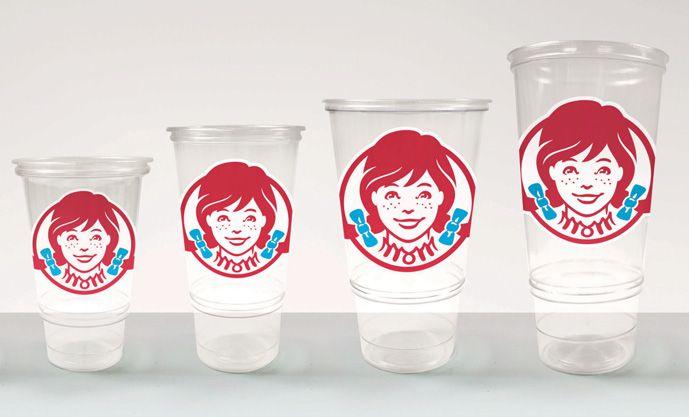
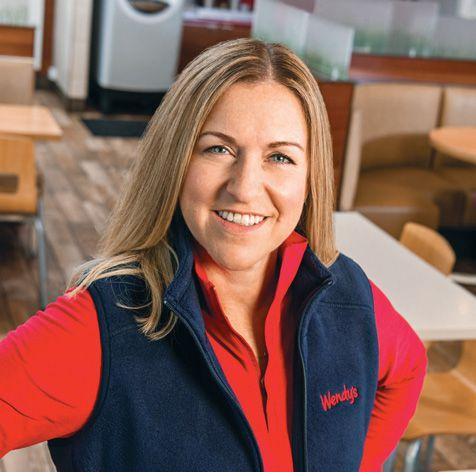

The most widely discussed environmental initiative across all industries centers around goals to reduce GHG emissions, typically referenced as a target of net zero, with benchmarks of 2030 and 2050 often cited. In October, McDonald’s Corp. announced a goal to cut its GHG emissions to net zero by 2050.
Wendy’s has been actively working through its goals and timelines for reducing its GHG emissions, relying heavily on the Science-Based Targets initiative (SBTi) [sciencebasedtargets.org].
“We have completed the first couple of steps and a key part is, within the last year, for the first time we recorded our Scope 1 and Scope 2 greenhouse gas emissions to the CDP Climate tool,” Esposito says. “We also conducted a life cycle assessment of our Scope 3 initiatives and reported those results. Going forward, we will continue to report on Scope 1 and 2 and continue to add Scope 3. By the end of next year, we’ll have assigned base targets for reduction of emissions across those three scopes and timeframes will be set as well.”
CDP is a not-for-profit charity that operates a global disclosure system for monitoring and tracking global progress toward

environmental sustainability. In 2021, more than 13,000 companies disclosed, up from fewer than 3,000 companies in 2010 and just 300 in 2004. CDP rates the companies based on their positive impacts toward climate change; in 2021, 200 companies made the CDP “A” list. No restaurant companies were among those 200; Wendy’s earned a “B” rating. [ CDP.net]
Restaurant companies like Wendy’s face a difficult challenge because the majority of their GHG emissions are attributed to Scope 3. In the simplest terms, Scope 1 and 2 emissions are owned or controlled by the company; whereas Scope 3 emissions are considered consequences of the company’s actions but occur from sources that are not owned or controlled by the company, such as supply chain vendors or franchise operators.
Only about 5 percent of Wendy’s restaurants are company-owned, and 99 percent of the chain’s GHG emissions fall into Scope 3.
“With our franchisees, we are still setting reduction targets, but we know a key part of that will be reducing the emissions of our restaurant operations and, in many cases, that will be directly related to energy use in the restaurants,” Esposito explains. “Over the last five years we’ve been part of the U.S. Department of Energy’s Federal Buildings Challenge; all our company restaurants participate as well as about 12 franchisees, about 1,000 restaurants total. There has been the benefit of being able to work together around the benchmarking and measuring of electricity and other energy uses, as well as the associated GHG emissions that go along with that. We have voluntarily taken on a commitment to reduce that energy capacity by 20 percent by 2025.”
Working together with franchisees is a win-win as it improves the footprint of each restaurant’s environmental impact and it reduces costs overall. The same holds true on the supplier side, and Esposito notes that the company’s goal to responsibly source its top 10 food categories by the year 2030 includes both environmental and social components.

“We are actively reaching out to our suppliers to share with them what our footprint looks like and the role that they play in that footprint,” she says. “We will be partnering with them to understand what their contribution to that footprint is and what sort of reductions they can make to help us meet our reduction targets. In many cases, our Scope 3 will be their Scope 1, and many of those suppliers have set their own targets for GHG
emissions and, even those that have not set targets are certainly working on efficiencies.”
Where more than 6,500 of Wendy’s 6,949 restaurants are franchise-owned, Chipotle’s 3,000 restaurants are 100 percent company-owned and operated, so its percentage of Scope 3 is lower than restaurant operations that are heavily franchised. Roughly 93 percentage of Chipotle’s GHG emissions fall into Scope 3.
“We have committed to reducing our absolute Scope 1, 2, and 3 greenhouse gas emissions by 50 percent by 2030, from a 2019 base year,” says Laurie Schalow, chief corporate affairs and food safety officer at Chipotle. “To keep ourselves on track with our 2030 goal, we have also committed to reducing our Scope 1 and 2 GHG emissions by 5 percent by the end of 2022.” Additionally, Chipotle has formed an internal climate steering committee “to guide decision-making, determine reduction targets, and drive strategy forward to reduce emissions in the most carbon-intensive functions of the business.”
Another topic raised throughout conversations of climate control is water conservation. It’s a concern for all restaurant operators and, in particular, for those where their footprint extends into drought-prone, high-risk geographies.
“In 2021, we developed a program to assess our water risks,” Schalow says. “We are in the process of completing our water risk assessment and then will develop programs to address water usage across our supply chain, ingredients, and restaurants. This assessment will allow us to better understand where our key water risks and impacts lie, and to advise the next steps for water stewardship projects in our facilities and supply chain.”
Similarly, Wendy’s has been focused on water improvements. After completing its own water risk assessment, Esposito says, “we identified that about 40 percent of our restaurants globally exist in areas that are considered moderate- to high-risk, and geographically its exactly where you would expect.”
Perhaps surprisingly, the vast majority of those sites, 85 percent, are located in the U.S.
The company joined the Department of Energy’s Better Buildings Water Challenge in 2019, and set a goal to reduce water usage in company-owned restaurants within the U.S. by

































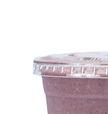


















20 percent by 2029, compared against a 2018 baseline.
“Last year we reduced it by 21 percent on the company side, and one franchised unit reduced their water usage by 31 percent, and they operate in Florida, which is a critical area,” Esposito continues. “There is no silver bullet solution, but after monitoring and measuring, certain solutions will make sense in different areas. One of the tools we’ve implemented at several of our company restaurants is metering technologies, so we can identify how water is being used and compare it to water usage in similar locations. In other cases, we’re using landscaping monitors and sensors that identify when it’s raining so the restaurants don’t turn sprinklers on when the ground is wet.”
Incremental, common sense adjustments can add up to sustainability success, but in growth-oriented business models, the organization’s success can further complicate progress toward environmental initiatives. In 2020, Chipotle set a goal to reduce its overall waste 5 percent by 2025. In 2021, due to the company’s rapid growth, overall waste actually increased by 7.5 percent.
However, Chipotle did implement significant steps toward waste reduction and the company recorded some relevant milestones. In 2021, Chipotle diverted 2.6 million cubic yards of waste through recycling, composting, and waste-to-energy. Specifically, the company composted 107,900 cubic yards of waste in 2021 and turned 68,490 cubic yards of waste into energy. The company also achieved a 50 percent landfill diversion rate.
Wendy’s is also making strides toward its goal of sourcing 100 percent sustainably packaged costumer-facing products by 2026, having taken its overall customer-facing packaging
Shake Shack, which has 369 restaurants across 32 states and 15 countries, launched a test last year of compostable, plastic-free, and carbon-negative straws. The pilot test, which was conducted in select markets, indicated that a single Shake Shack restaurant reduced carbon emissions by 4,146 metric tons in a single month simply by using the carbon-negative straws, which were sourced from Restore Foodware.
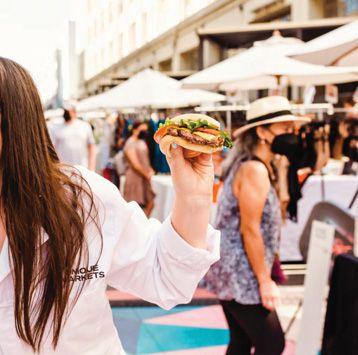

In a similar initiative implemented in fourth quarter 2021, Shake Shack reduced its cardboard usage by more than 1,000 pounds weekly by increasing its burger case pack by 4.5 pounds per case. The company has also begun testing solar panels in five locations, is using LED/motion-sensor lights and energyefficient equipment in many stores, and is evaluating adding EV charging stations in the future.
There is no single action or answer to positively impact the climate, as Esposito notes, “It’s a combination of different things. One of the things Wendy’s has done is renovate our restaurants to use more energy-efficient equipment, HVAC systems, lighting ( most have converted to LED in the parking lot ), and building materials. We use a double-sided grill for most of our restaurants, and we’re actually rolling out a new model that is more energy efficient. We’ve also converted to a ware wash machine at several hundred restaurants and these are more energy efficient as well as more water efficient.”
Looking to the future, Wendy’s plan for new construction as well as remodels includes EV stations in the schematic. Although there are only a few EV stations currently in place at Wendy’s stores, it is something that can be incorporated as the use of hybrid and electronic vehicles rises.
The move to corporate responsibility has translated directly into corporate accountability. At both Wendy’s and Chipotle, executive compensation is now tied to the achievement of ESG ( environmental, social, and governance ) goals.
At Chipotle, Schalow notes, “The 2022 annual incentive bonus for our officers can be positively or negatively impacted by up to 15 percent based on the company’s achievement of our ESG goals.”
And at Wendy’s, Esposito says: “This year, for the first time, 10 percent of the annual incentive compensation for our executive population, which is vice president and above, will be tied to the achievement of ESG goals.”
from 42 percent sustainable in 2019 to 48 percent in 2021. Most notably, the sourcing of cups and lids improved from 6 percent sustainable materials to 19 percent sustainable in 2021, and the category of straws, cutlery, napkins, and liners improved from 69 percent sustainable materials to 73 percent.
Even restaurant operations with hundreds of stores instead of thousands can have a substantial impact. New York-based
Key to achieving the goals is employee engagement, and that is an area that she has been most pleased with at Wendy’s: “This is a team sport, it is not something that one person or one department can impact, I’ve been pleased at how much energy there is within our organization for focusing on these initiatives, whether food, or footprint, or people-related. If anything, we have more ideas than we can implement in terms of how to move forward. so that’s really encouraging.” q
Connie Gentry is a regular contributor to Food News Media and the former editor of FSR magazine. She is based in North Carolina.
In the early days of the pandemic, George Frangos wouldn’t say that his fine casual Farm Burger was sitting pretty, per se, but it was definitely faring better than most. This good fortune was due in large part to the concept’s core values. When Frangos and cofounder Jason Mann opened the first location in Decatur, Georgia, in 2010, collaboration with nearby farmers and ranchers was paramount. The brand’s sourcing practice not only yielded a higher quality product, it also kept dollars in local agriculture.
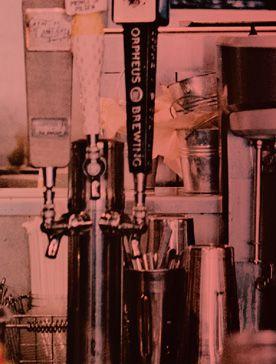


A dozen years and about as many locations later, Farm Burger’s direct-to-the-source approach shielded it from some of the early chaos of COVID-19.



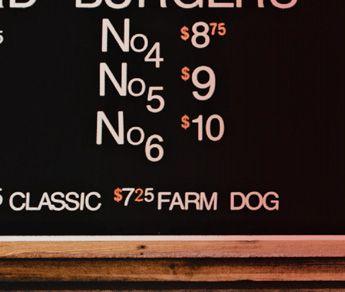


“As you had disruptions to the meat industry and supplies with processors and big slaughterhouses being shut down and COVID outbreaks and everything, we didn’t have those issues because we work directly with farmers and directly with small processors and really have a vertically integrated chain around our proteins,” says Frangos, who is also the brand’s president. “Our prices held tight, and we didn’t have any problem with supply. We were actually in a strong position, kind of unknowingly so.”


Recent bottlenecks and shortages have restaurants reevaluating their supply chains—and sustainability might just be part of the solution.










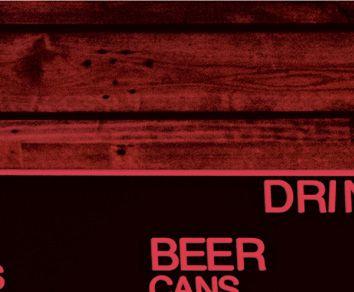

 /
/



But the extent of these supply chain repercussions was not immediately visible. Instead, they unspooled gradually, casting ripples up the supply chain. As orders from restaurant clients ebbed, manufacturers and distributors curbed output and, in some cases, laid off employees. When orders started to ramp up again, there was a shortage of not only product, but workers, too.
Farm Burger felt the effects of the second phase of this reaction. It struggled to source sustainable paper and recyclable products; when it succeeded, the price could be double the usual amount. As of this spring, Frangos says the brand ( like many restaurants ) is still navigating a shaky landscape, with product availability changing on a near-weekly basis. Furthermore, it’s experiencing delays on specialty products like goat cheese. When demand faltered, farms bred fewer goats; now they’re having to grow the herds once again.
All too common quagmires like this have restaurants rethinking how they source ingredients and other products. Sustainability also comes into play, and not just for altruistic reasons. A shorter supply chain, as with Farm Burger, offers more control and dexterity for when the next disruption occurs. It also provides a baked-in narrative that curries favor with a growing number of consumers.
“For the operator, it’s wise to centralize their purchasing and localize it because they feel like they control it better, with fewer inputs and maybe more knowledge about those places they’re sourcing from,” says Laurie Demeritt, CEO of market research firm, the Hartman Group. “So I think there are good opera-
about reducing the carbon footprint. And still for other people, it might mean something else,” says Aaron LaMotte, vice president of supply chain management for North America for foodservice and facilities management company Sodexo. “So, sustainable sourcing over the last 10 years has become more of a focus from a broad perspective. We’ve had a lot of key stakeholders in the industry share with us how important it is to them.”
Just as restaurants might become overwhelmed by the many faces of sustainability, their partnering companies must also juggle multiple initiatives. LaMotte says one of the trickiest tasks for distributors and management companies is the beingeverything-to-everyone conundrum. One restaurant client might pursue sustainability by curbing their energy consumption, while another chases the same goal but by reducing their carbon footprint. All aspects of sustainability lead back to a central goal, but the entry points can be far apart. The broader Soedxo’s customer base, the broader its approach to sustainability has to be, LaMotte says.
A number of restaurants also employ a holistic methodology in building greener supply chains. For nearly four decades, Southern California–based concept Rubio’s Coastal Grill has sourced wild Alaskan pollock for its tacos. The whitefish, which has a mild, cod-like taste, is considered one of the more sustainable species, a reputation that has elevated its appeal in recent

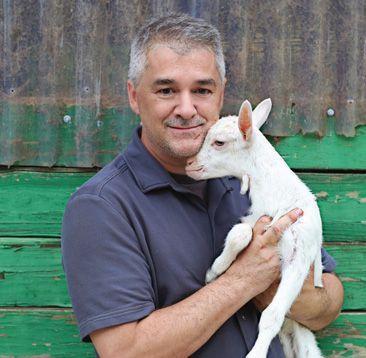
tional reasons for doing this … but there’s a lot of other rich narratives about that sense of place, about money circulating locally, about supporting humans that are local.”
Nevertheless, sustainability in the supply chain encompasses more than local sourcing. It’s also about the path a product takes from its point of origin to the restaurant. The products themselves are another facet, whether they’re ingredients or packaging, the latter of which has faced increased scrutiny amid the pandemic-era spike in single-use disposables.
“We don’t have a universal definition as to what sustainable sourcing is. For some people, that might be local sourcing, buying in the communities in which we live. For some people, it’s

years. Accreditations from Alaska Responsible Fisheries Management and Best Aquaculture Practices guide the brand in its vendor selection. It also collaborates with organizations like the Monterey Bay Aquarium and Marine Stewardship Council.
Seafood might be at the crux of Rubio’s sustainability practices, but it’s not alone.
“Our focus on sustainability ranges from our seafood to land proteins to packaging,” says Angela Scheufele, director of supply chain for Rubio’s. Napkins, paper towels, and tissue are made of 100 percent compostable fiber. Last year, the chain used more than 122 metric tons of recycled fiber in these products.
But, the pandemic disrupted Rubio’s otherwise stable supply
















































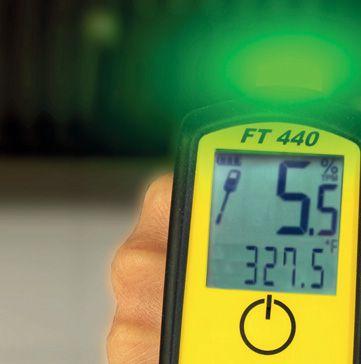
















chain. Shortages across the board—product, labor, transportation—plus commodity inflation and volatility have made for a challenging two years. The experience reinforced not just how important Rubio’s vendor relationships are but also the value of having backups.
“We have always believed in the benefit of dual sourcing when it makes sense, but now it is more important than ever given current conditions. We are prepared to pivot quickly if needed,” Scheufele says. “For example, we approved wild ono [wahoo] as a temporary alternative to our wild mahi mahi as mahi has been in short supply this season.” Rubio’s is also testing wild hake ( a pollock substitute ) at its Arizona restaurants as a precautionary step.
On the operational front, Rubio’s is working to incorporate GS1 global traceability standards and RFID (radio-frequency identification) technology. While conversations around traceability often pertain to food safety, GS1 barcodes can help verify sustainability claims and cut down on so-called greenwashing.
Beyond tracking technology, restaurants are also taking other steps to shorten products’ transit distances. During the pandemic, Rubio’s worked with its distribution partner to optimize freight lines to the restaurants—with locations in California, Nevada, and Arizona—and temporarily trim the number of deliveries when business was slow.

Even prior to 2020, New England–based Oath Pizza practiced the idea of doing more with less, something that has proved especially advantageous as of late.
“Oath has always been selective about the products and the menu we offer. Through some really thoughtful selection and cross-utilization, we’ve been able to put together a menu that caters to all tastes,” says Pam McMorrow, director of supply chain and product innovation. Indeed, the fast casual offers vegetarian, plant-based, gluten-free, and dairy-free options.
“Another piece of it is we’re really mindful about the impact on the planet when we’re making our decisions on what we bring in,” she adds, offering Oath’s use of humanely raised Applegate proteins and recyclable packaging for non-pizza dishes as examples.
But even the versatility of Oath’s ingredients couldn’t shield it from gridlocks along the supply chain.
“The biggest things were product deliveries being delayed and complete product outages; if it wasn’t coming in late, it wasn’t coming in at all,” McMorrow says. “We had to find alternative methods for deliveries like direct shipments or drop shipments straight from the manufacturers.”
She adds that thanks to a nimble team, Oath has been able to take many of these disruptions in stride. Like Rubio’s, it also sought alternatives to products that were tied up in transit or unavailable. In many cases, the substitutes were closer to home.
Before COVID, about 75–80 percent of its products were domestically produced since Oath would import some specialty items, like gourmet cheeses, from overseas. Now, McMorrow estimates the portion has grown to 95 percent. The switch also saved money by eliminating trade tariffs and shortening the shipping distance. Through it all, the brand was able to maintain its standards; as a bonus, the less time in transit also translated to a fresher product with a longer shelf life.

McMorrow says the final piece was turning to creative workarounds with ingredients that, while still fresh and high quality, might not be what was needed. For example, if crusts arrived that weren’t the right size for a pizza, the restaurants would cut them into squares and use them as croutons on the caesar salad.
“We put laser focus on product inventory—or par levels— based on accurately forecasted sales, and we completely tightened up our purchasing practices to bring in only the amount of product needed,” she says. “By doing that, we reduced the amount of stock in our restaurants and the amount of product in the supply chain. It also reduced the risk of having extra that could go to waste.”

Distributors are also adopting a repurpose mentality. In late March, US Foods became one of the first major broadline food distributors to join the Upcycled Food Association, an organization whose members salvage ingredients bound for landfills and incorporate them into food products.
US Foods’ first foray into upcycling is the Hilltop Hearth Pub Grain Hamburger Bun, which uses spent grain flour. A byproduct of beer brewing, spent grains not only find new life as flour, they also infuse the buns with a mild, earthy, and sour flavor.
One area of sustainability that McMorrow says tends to be overlooked are the chemicals used along the supply chain and in the restaurants.
“I don’t think people realize how damaging it can be if you’re using the wrong products, how damaging it can be to just pour it down the drain. That drain goes directly to our water supplies in some cases or watersheds, and it’s not often thought about,” she says. “Restaurants have to do their homework on those choices; you have to know what’s in these chemicals and how their contents affect the environment.”
In addition to third-party accreditation groups, manufacturers and distributors are creating their own initiatives as a way of vetting products for their restaurant clients. At US Foods, this culminated in the Serve Good program, which launched in 2016. To be part of Serve Good, products must not only have claims of sustainable sourcing or waste reduction, they must also arrive in eco-friendly packaging.
Because so many factors are involved in meeting the criteria, US Foods divided them into five categories: agricultural practices, sustainable seafood, animal care, responsible disposables, and waste reduction. “Almost all of the products under the Serve Good umbrella have the reassurance of some third-party certifier. So we’re working with Non-GMO Project Verified, USDA Organic, Marine Stewardship Council, Forest Stewardship Council,” says Hannah Koski, director of corporate social responsibility at US Foods. “Some of these third party certifications have a long history, but then others are new, and we’re excited to be able to incorporate those as well.”
In just six years, Serve Good has quadrupled the number of products (under US Foods Exclusive Brands ) in its stable to 770.
The broadline distributor is also making strides in how these items are transported. In California, its distribution centers are moving to 100 percent renewable diesel. In Texas, it’s converting compressed natural gas trucks to use renewable natural gas fuel. US Foods is also bringing 15 electric trucks into the fold. All three agenda items are slated to be completed by year-end.
“How [a product] is delivered is also really important,” Koski says. “We flagged a lot of initiatives both in our buildings and in our routes to improve our efficiency and reduce our environmental impact overall.”
Steps like these aren’t going unnoticed by consumers. While the average person might not be aware of initiatives at companies like US Foods and Sodexo, they do pay more attention
to the efforts of consumer-facing businesses, like restaurants and retailers. Whether the restaurant is building sustainability practices in-house ( as with Farm Burger ) or collaborating with third-party partners, the messaging resonates—perhaps even more so now than pre-2020.
“I think one of the things the pandemic did was just shine more of a light on the food supply system, and that’s everything from the growers to the producers and distributors to the folks who work in foodservice, who are making the food, who are delivering the food,” the Hartman Group’s Demeritt says. “Knowing some of those stories and those narratives about not just what’s in your product, but also where those ingredients are coming from is a good starting point.”
That’s one step all restaurants can take in both better understanding their own supply chain and communicating those details to customers, she adds. In terms of sourcing, the terrain has yet to stabilize, making it hard for many operators to refocus on their own sustainability practices. For this reason, Sodexo’s LaMotte recommends that restaurants stay on their toes as conditions continue to evolve.
“I would say that we’re not out of this yet. [ With] things like the bird flu situation that’s happening right now and the labor market that continues to have constraints and inflation being such a front-of-mind issue for all of our operations team, I don’t think we’re out of some of the more difficult parts of all of this yet and we may not be for the better part of the next year or so,” he says. “It behooves everybody to be patient and work to the best of their ability with their supply chain professionals.”
Building relationships has been the bedrock of the hospitality sector from the very beginning, and if anything, the adversity of the past two years reinforced how important the people side of the industry truly is. The restaurant-customer dynamic has been frequently spotlighted, but the ties between operator and farmer, rancher, distributor, manufacturer, etc. are just as vital to foodservice’s longevity.
Over its 12-year history, Farm Burger has cultivated relationships with many small businesses as it expands into new markets. After a COVID-necessitated pause, the restaurant is continuing this practice. In January, it debuted a location in Athens, Georgia, that had been delayed since 2020.
Prior to opening, the Athens store had suppliers locked in for its proteins, like grass-fed beef, and other menu staples, but it’s still searching for producers of ancillary items, with the goal of local, organic ingredients supplanting conventional ones.
Building these relationships takes time, but for brands like Farm Burger, it’s worth the effort, whether from a business standpoint or a sustainability one.
“When we go into new markets, there’s this learning curve. You don’t always know all the proper smaller- medium-size providers or growers or farmers or cheesemakers. It always takes time, and sometimes they find you. Sometimes when you get into a market, 3–6 months later, you find new local connections,” Frangos says. “That’s an exciting part of it, but it never happens the day we open.”
Autonomous technology has begun to emerge, offering operators and customers a more environmentally friendly—and cost-effective—approach.
BY TREVOR GRINERFifteen years ago, the first-generation iPhone hit the U.S. market. The sleek, paradigm-breaking design captured the imagination of consumers. Touch screens, apps, and other features would soon become a standard for mobile technology.
Today, innovation is advancing at an even faster clip. And it’s particularly evident in foodservice—a sector long considered a laggard to tech evolution—where futuristic solutions are popping up on the back-end of a global pandemic. Autonomous delivery being one of them.
Driverless delivery vehicles, drones flying through the sky with pizzas and groceries, and automated robot servers gliding through dining rooms, are all now realistic functions, as much as it might sound like an episode of “The Jetsons.”

“It’s going to become very ubiquitous,” says Juan Higueros, chief operating officer of Bear Robotics. “You’re going to see automation playing a huge role in the foodservice and hospitality space, both inside and outside of the restaurant. If automation was a baseball game, I’d say we’re just now entering the second inning.”
Bear Robotics is a California-based company helping to lead the charge toward automation. The company, which creates hospitality robots, is one of several brands focusing efforts and resources on reshaping the restaurant landscape.
Bear’s hospitality robots act like servers by delivering drinks, dropping off food, and helping bus tables. Higueros says there are several advantages associated with using these, but none more important than the time it frees up for employees to be, well, more hospitable.
“It allows the employee more time to be more creative,” he says. “It gives them more time to spend on the people their serving and it creates a much more embodied working environment for the employee. It creates better culture, which results in more return customers because they’re getting that true customer experience through customer service.”
From an operator’s viewpoint, there are other advantages to consider as well. Bear’s hospitality bots can save employees miles of walking during shifts, leading to a more rested, focused staff. Higueros says servers at many restaurants can walk upward of 20
miles per week, adding physical stress to an already challenging occupation. By using automated servers in a collaborative nature, operators can increase productivity while simultaneously making their employees’ lives easier.
Another plus: ROI.
“There are significant, significant savings,” he says. “It’s a slam dunk.”
Owning one of Bear’s hospitality bots requires a one-time purchase. Compared to the investment associated with recruiting, training, and retaining talent, the upfront fee can save operators plenty of capital, Higueros says, especially in today’s climate where turnover continues to soar and labor costs in general have skyrocketed.
There’s also the ongoing topic of wage inflation. As minimum wage in many states climbs and competition to bring in staff drives up starting salaries, tapping automation can make the difference between a business scraping by and one experiencing comfortable margins.
“Whether it’s in California, where minimum wage is $15.50, or
Texas where the minimum is $7.25, there are significant savings from the jump,” Higueros says, adding the hourly cost of one of Bear’s hospitality servers runs about $2.50.
Hospitality bots are just one part of the automated delivery conversations. Brands like Nuro, a California-based robotics company focusing on driverless vehicles, are also making headway.
Nuro specializes in driverless vehicles and is partnering with some major players in the space in an effort to shift delivery fulfillment. At the end of 2021, Nuro announced it would partner with 7-Eleven on an autonomous delivery pilot using Nuro’s fleet of Toyota Priuses, with plans of later introducing Nuro’s R2 bots, the company’s autonomous custom-built robots designed to transport products and goods without any occupants in the vehicle. The test is in Mountain View, California, and is accessible through the 7NOW app. Nuro was the first autonomous vehicle company to receive a deployment permit from the California DMV. Autonomous delivery services like the one offered by Nuro solve several problems operators

are running up against, including the lack of available delivery drivers.
“We are seeing demand for autonomous delivery across all types of industries and businesses, and we’re working to address that demand across food, grocery, parcels, convenience, prescriptions, and more,” says Cosimo Leipold, head of partnerships at Nuro. “The demand was there before the pandemic, and it’s only growing. People want things quickly and at an affordable price.”
“We believe this technology will increase the overall market, while creating more fulfilling jobs inside restaurants and in other roles besides delivery––and at the same time, lowering the cost of home delivery for consumers,” he adds. While convenience and cost-effective business practices are paramount today, one of the biggest benefits of automated delivery, Leipold says, is the impact it has on the environment. Partnering with brands like Nuro, he says, can go a long way in transforming an ordinary business to a sustainable one.
Leipold adds Nuro’s occupant-less delivery helps eliminate unnecessary trips to stores




and restaurants, which he says make up roughly half of the errands Americans run.
“The fact that the transportation sector is the number one contributor to greenhouse gas emissions in the U.S., it’s frightening to realize how much pollution is created by these short trips,” he says.
According to Steer, a global transportation consulting firm used by Nuro, autonomous delivery services can protect the environment by avoiding up to 407 million tons of CO2 over the course of a decade, which is equivalent to the residential emissions from the four largest cities in the U.S.

Nuro uses 100 percent renewable energy generated from wind farms in Texas to power the brands’ battery-electric fleet, meaning the entire operation is sustainable. “Ultimately, we believe the future of delivery must be zero emissions, which is why we are so excited about the potential of our battery-electric vehicles,” Leipold says.


Futuristic technological advances in the space don’t stop at hospitality bots or driverless delivery vehicles. Flytrex, a company specializing in drone delivery, is also breaking onto the scene and recently partnered with Jersey Mike’s. Customers within Flytrex’s delivery zone can order food through the Flytrex app from partnering restaurants. Then, Flytrex’s drones fly within the designated flight radius and deliver the food from the sky, lowering the product(s) with a rope and hook right into the backyard of the customer. Currently, Flytrex is only focused on suburban markets. Yariv Bash, CEO and co-founder of Flytrex, says this is because it’s more economically and strategically viable to service those areas. There’s also the issue of getting clearance from the FAA to fly the drones, which is much easier in suburban skies versus urban settings.
“This is a very nasty process,” Bash says of trying to get clearance from the FAA. “Only three companies focused on home drone delivery are doing what we’re doing.”
Like the driverless vehicles at Nuro, Flytrex’s drones are also completely electric, meaning they have a much smaller carbon footprint than other traditional delivery models. “It’s a lot faster and a lot quieter,” Bash says. “We offer a much better solution for the customer and the restaurant. It’s a win-win for everyone.” q
mark them with a harmless V-shaped cut on their tails to let others know. This is done, Annie Tselikis explains, because survival of lobster eggs is tight. Looking at the bigger picture, much of Maine’s economy is reliant on sustainable lobster reproduction.
The industry is the backbone of the state, and to emphasize this to franchisees, Cousins Maine Lobster hosts operators and takes them through lobster boats, the processing plant, and distribution system.
“They are connected in Raleigh or Houston or Dallas or Los Angeles through this fishery back in Maine because the supply chain is tight and because this is so important for our coast and for our community and our culture and traditions,” Annie Tselikis says. “So we want everybody to know that.” To efficiently distribute lobster from Maine to the rest of the country, the company works with partners to calculate how many pounds it will need over the course of multiple years, and then breaks that down to quarterly, monthly, and weekly.
Jim Tselikis says product reaches Raleigh and Charlotte the same way it does in Columbus, Ohio. The supply chain ends with franchisees, who typically run their own commissary. “We make sure that the food is coming to them cooked and prepared the same way, same quality, same specs from our teams so that we can all then ultimately use that in a lobster roll, into a lobster quesadilla, into a lobster taco, so that the experience for the customer is the same every time,” Jim Tselikis says.
By the end of 2022, Cousins Maine Lobster expects 19 openings, including eight new cities. In the first quarter, the brand opened in Austin and San Francisco for the first time, and existing franchisees inked deals to expand in Pennsylvania, Delaware, and Tampa, Florida. The chain said in April it’s looking for further growth in markets such as Chicago, Indianapolis, Kansas City, Minnesota, Orlando, St. Louis, Virginia Beach, and the Pacific Northwest. Cousins Maine Lobster’s sales increased 37 percent year-over-year in 2021.
Although it’s experiencing growth, the familial culture has remained intact. On the back of T-shirts is the phrase, “family first,” which Jim Tselikis says is more than a marketing tool. q
new locations in the near future. Noodles also has other environmental initiatives in the works.
“All new locations are opened with 100 percent LED lighting and high-efficiency, Energy-star certified appliances,” Moore says. “We’re working to transition exterior lighting at current locations to LED lighting, and we’re continuing to test more sustainable packaging options and environmentally friendly best practices.”
For lighting, Noodles works with a company called Villa, “which has a high-efficiency department that assists in providing eco-friendly lighting solutions for us,” Moore says. With regard to kitchen equipment, the brand says 95 percent of what has been installed is high efficiency.
A recent Noodles opened with a DOAS (dedicated outdoor air system) installed on the roof. The company says it reduces energy use by 30 percent and provides 100 percent clean air within the building. Moving forward, the plan is to install this type of system in any new restaurant that does not already have a provided rooftop HVAC system.
Noodles has encouraged franchisees to jump onboard with its plans, and Moore says they have responded positively to green initiatives so far and continue to partner with the company to implement new practices and identify areas for opportunity.
“Our values drive our business, and our franchise partners help us bring our values to life with a shared commitment to nourish and inspire every team member, guest, and community we serve,” Moore says. “Our sustainable straw initiative has been rolled out at all franchise and company-owned restaurants, and we continue to partner with our franchise partners in implementing sustainability efforts.”
When asked what advice she and Noodles could offer other brands, Moore replies, “I would tell businesses to stay true to their values and constantly seek improvement and excellence in their business. For Noodles & Company, we are continuing to introduce more green-friendly initiatives to support our mission to put people, food and community first. We believe that changes start from the inside out, which is why we’re committed to making the world a better place, one bowl of noodles at a time.” q















What was your first job?
































I am a California native, born and raised in SoCal. I started working in restaurants as a young teenager in Garden Grove, beginning as a cook in a local pizza chain, Perry’s Pizza. My first boss and mentor was a franchisee, John Vairo, who was a hands-on owner-operator.

What’s your favorite menu item at Farmer Boys? Tough question. I have to give you a situational answer. My go-to is the Chopped Cobb Salad, a meal in a bowl. When a full meal is not in order then I get the Fried Zucchini, which is much heartier than you might imagine.
What’s your favorite cuisine aside from Farmer Boys? Having started in a pizza place I love Italian food (and a nice glass of Chianti). Who inspires you as a leader? It may sound cliché but the people around me. I am continually amazed at how eager our team is to create success and get it right.
What’s the best piece of advice that other restaurant executives should hear? Pay attention to the people around you. They are often smarter than you individually and are certainly smarter than you collectively.

What are some of your interests outside of work? I spend most of my time hiking trails or on my mountain bike. My wife and I have four incredible adult children who are making their way in the world, and we love to get them together when they can get “home.”
Farmer Boys is a Southern California-based fast casual known for its award-winning burgers and exceptional service. Today, we boast 101 corporate and franchised locations across California, Nevada, and Arizona. I joined the team in January 2020, just before COVID19 hit. Taking over during the pandemic was a mixed bag. On the plus side, Farmer Boys had a planned transition as I first joined as SVP of Operations and had six months to become familiar with the brand. On the flip side, the concept needed to shift priorities, but we managed to thrive through solid communication.
My start began at Taco Bell as a GM in the research and development sector. I worked up from district manager to regional training to project manager, staying for 10 years. My final post was leading the ops services team and express operations group. Following Taco Bell, I headed to senior ops positions at Koo Koo Roo and El Pollo Loco. Most recently, I was with The Coffee Bean & Tea Leaf in franchise ops, followed by a
similar position as VP of franchise for Del Taco. While working at Taco Bell, I met Karen Eadon, a world-class marketer who became Taco Bell’s VP of operations services. Eadon became a personal mentor and we worked together at several companies. At El Pollo Loco, my direct supervisor and mentor was Ken Clark, who oversaw the company’s franchise operations, and we both worked alongside Eadon, who was CMO at the time. Both Clark and Eadon went on to become president of Farmer Boys. Following in Eadon’s footsteps at Farmer Boys was a huge personal honor. Upon joining Farmer Boys pre-COVID, the concept placed a sharp focus on drive-thru. As COVID set in, we accelerated efforts by bolstering training, narrowing focus, and installing new technology such as timer systems, new headsets, and outside order-taking devices. I also instituted a weekly video call for all franchisees and general managers, regularly having over 100 participants storewide, to provide updates and reminders, and that call remains in place today. q

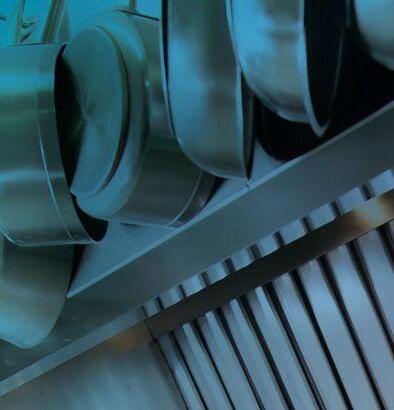













THIS YEAR, FOODSERVICE OPERATORS are facing challenges like never before. With vast supply shortages, rising costs, and the toughest labor market the restaurant industry has ever seen, it’s no wonder restaurants are searching for relief any way they can.
It comes as no surprise, then, that many restaurants are looking to technology for solutions that can take pressure off their labor force. And, thanks to the innovation of vendors serving the restaurant industry, operators are finding that support in the form of back-of-house automation, smarter cooking equipment, improved communications tools, and software that provides incisive guest and crew insights. Here, vendor partners explain how their technology cannot only help restaurants operate more efficiently despite the industry’s challenges, but they also explain how their support can give staff and managers back time to do what they do best: serve customers. Read on to learn more about how technology can help your brand.
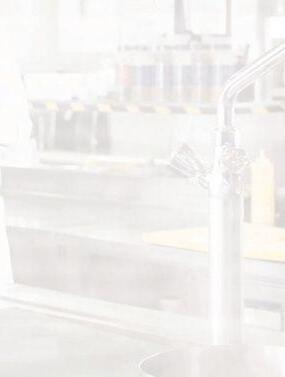

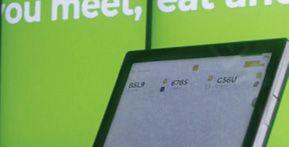
WITH THE RISE OF HOME DELIVERY and drive-thru popularity, new pressures have arisen in the restaurant industry. Operators face a significant increase in demand while battling an ongoing labor shortage, creating additional costs and friction in the operational process. As a result, the customer experience has become an afterthought.
One of the most significant bottlenecks restaurant operators face is order errors. When customers receive a different order than they paid for, they are more likely to leave an unfavorable review. Negative reviews damage the restaurant’s reputation in more ways than one. Businesses with better ratings are ranked higher on delivery apps and web searches—directly impacting sales.
Recognizing a void in the market for restaurant technology that reduces order errors, Acrelec developed a simple yet efficient solution that addresses the most critical items on the minds of restaurant leadership—customer satisfaction and retention. The solution stems from two years of R&D and live feedback from restaurant operators, who have put it to the test.
Harnessing the power of AI technology and the precision of a scale, Acrelec’s Double-Check dramatically improves order accuracy with automated confirmation of bag contents based on a patented weight prediction algorithm. Here’s how it works in 4 easy steps:
1. Crew members place an order on the AI-powered scale
2. Collection order is selected on the screen.

3. Double-Check’s exclusive patented AI algorithm runs in less than one second. It shows the actual weight of the order versus what is predicted.
4. If no errors are identified, the order is confirmed, and the bag can be sealed and handed to the customer. The solution takes the guesswork out of order preparation— an intuitive interface ensures the weight check is not a hindrance for crew members. The result is a 40-percent reduction in bagging mistakes.


For delivery, the system is independent of the restaurant’s POS to facilitate seamless deployment and comes fully connected to Acrelec’s monitoring platform for efficient supervision.

Order checks must be traceable and provide data to the managing team for continuous improvement. Each transaction through Double-Check is recorded, reporting the predicted and actual weight. In case of an error, products are grouped to identify the issue quickly. In turn, restaurant teams are better equipped to provide the operational data and analysis needed to help audit in case of disputes, translating to a 50-percent decrease in order refunds.
Double-Check integrates with food delivery apps for instant feedback on customer complaints, encouraging better rankings in food order apps, which increases positive ratings by 0.2 to 0.3 points (out of 5) and channel sales by 10–15 percent. According to Acrelec’s pilot program, 94 percent agreed that the use of the solution improves customer ratings on the delivery partners app and , therefore, increases business potential.
This new addition to Acrelec’s rich suite of end-to-end software and hardware solutions is ideal for streamlining home delivery and drive-thru operations. RET



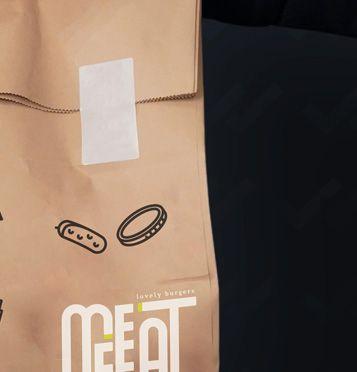







Don't send any more incorrect orders.








won’t come back.
That’s why many brands are investing in technologies to optimize takeout and delivery. With OrderHQ Smart Food Lockers, developed by Apex Order Pickup Solutions and manufactured by Merco, a Welbilt brand, restaurants increase labor efficiency, eliminate mix-ups and remakes, and gain data insights for improving this critical area of their business.
When restaurants manage takeout and delivery orders with OrderHQ Smart Food Lockers, incredible change happens.
The customer is happier because pickup is secure, contactless, and takes less than 10 seconds. They don’t have to search through multiple bags or wonder if anyone handled their order.
Delivery drivers are happy, too, because lockers can sometimes be located in an exterior wall, so drivers don’t even have to come inside—getting them in and out quickly, and onto their next order.
Employees immediately save time and steps. They don’t have to check on the order, because they know it’ll be picked up by the right person. That helps increase throughput and reduce stress.
THERE’S NO DOUBT THAT DRIVE THRU, delivery, and takeout sales were the restaurant industry’s rock stars over the past two years. Throughout COVID restrictions, these channels helped countless operators keep the lights on when in-house dining wasn’t an option. Customers quickly got hooked on these new conveniences. In fact, the NPD Group reported in late 2021 that off-premises sales remained 20 percent over pre-pandemic levels.
However, this has created a few problems. Takeout is often inefficient for employees, disrupting their usual processes. Picking up an order doesn’t always go as planned, either—sometimes food or drink is taken by the wrong customer or delivery driver. Or, a driver arrives early and has to wait in the lobby, leading to crowding and noise. Lost orders must be remade, which eats into already-slim margins.
Worst of all, according to the “State of What Feeds Us, Vol. 5” report from Bluedot, one in every two customers say they’ve had a poor pickup experience due to lines, unexpected waits, or missing orders. And when a customer has a bad experience, they often
OrderHQ lockers provide a quick return on investment. Here’s how:
• A single locker typically reduces labor by at least two hours each day.
• Fast, reliable pickup means customers will use pickup again, helping operators own more of the customer experience— and profit margin.
• There’s less food waste and fewer costs associated with order mistakes and theft.
Operators also now have valuable data insights for every step of the order journey—from order creation, to the exact moment of pickup—across every store. This data helps manage their takeout and delivery channels based on metrics, not guesswork.

Now that takeout and delivery are more important than ever, getting those processes and experiences right is critical. OrderHQ Smart Food Lockers make off-premises orders more convenient, efficient, and profitable. RET

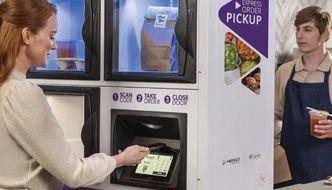






RESTAURANTS OFTEN FOCUS the bulk of their culinary efforts on creating distinctive food selections. Yet while many operators know beverages offer better margins than food products, unique housemade beverages can also provide an easy way to increase menu diversity and guest satisfaction, as well as to drive sales.

“Craft beverages allow operators to provide elevated offerings to their guests to improve the experience, as well as open a new revenue stream,” says Sean Hsu, CEO of Botrista. “With decreasing soda sales, brands can provide additional options to guests. Specialty beverages that feature functional or healthy ingredients can offer restaurants a chance to recapture those add-on sales.”
Drinks can also be an asset for off-premises occasions, as operators can increase check size by offering guests something they can’t find at home. “Providing a great delivery experience is key,
so having unique items online is important,” says Hsu. “Ensuring beverage offerings are presented in an attractive way can go a long way in driving guest check.”
Despite these benefits, some operators have been reluctant to rollout specialty programs, because they have traditionally been difficult to manage. Not only do they require prep, a bar, and labor to execute, but ensuring each beverage is consistent can be challenging. However, now, with Botrista’s automated algorithmic technology, any restaurant can offer premium beverage upgrades in just 5 square feet without increasing operational complexity.
“We work closely with our customers to develop a menu that complements their food offerings and achieves their business objectives,” Hsu says. “Our system allows operators to gauge sales and customer feedback to optimize their menus, and our easy-touse interface lets any staff member, by simply pressing a button, craft house-made beverages in 20 seconds.”
The Halal Guys worked with Botrista to provide a new drink menu for their guests. Andrew Eck, vice president of marketing, says, “Our partnership with Botrista was a way to not only introduce craft beverages in an easily-manageable way, but it offered a way to add some excitement to our beverage program. And because we could rely on Botrista’s craft drink expertise, we were able to optimize for the best flavor combinations for our specific menu and drill down on best sellers.”
Botrista’s flexible BiB format also allows restaurants nearly endless choices for their beverage menus, including beverages such as infused iced teas, flavored lemonades, energy drinks, iced coffees, sparkling beverages, and more. By providing compelling options, restaurants can provide craveable beverages to set them apart from the competition and draw customers back time and again.
“Botrista is your beverage partner—we go beyond offering brands the equipment,” Hsu says. “We’re here to support restaurants. With high quality craft beverages, operators can charge more, leading to larger check size and larger penny profit for each transaction.” RET
From order to pour, any employee can create specialty beverages in 20 seconds.
“Craft beverages allow operators to provide elevated offerings to their guests to improve the experience, as well as open a new revenue stream.”
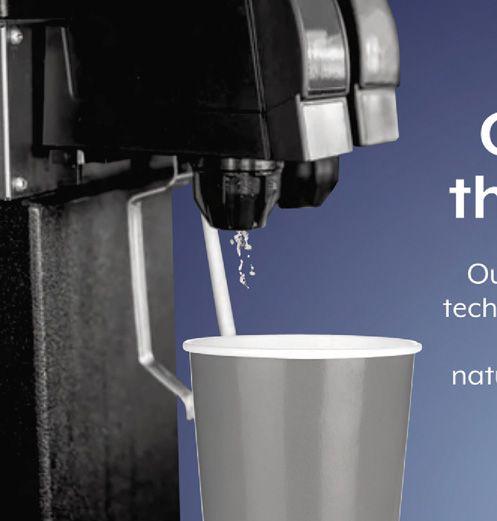



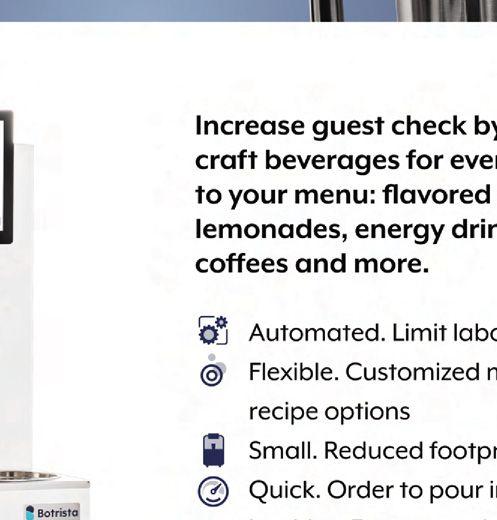


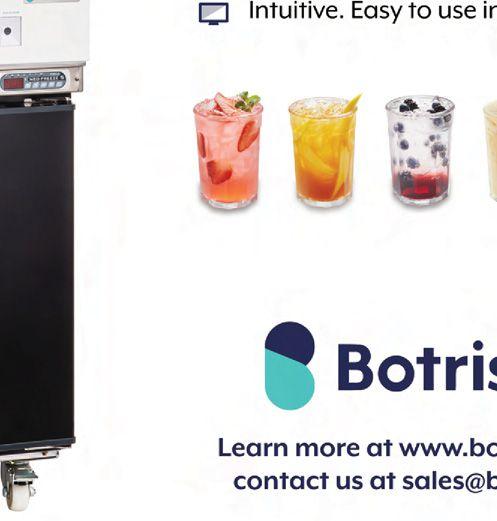
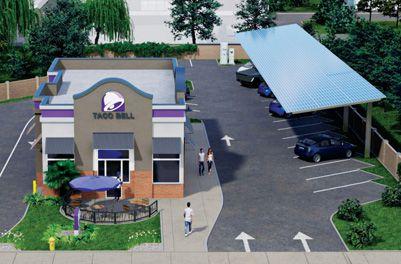

IF RESTAURANTS COULD ATTRACT NEW CUSTOMERS, offer them a money-saving convenience, cut up to 20 percent of your energy costs, and help the environment, they might have to invest thousands of dollars, right? Wrong.
Restaurants don’t have to spend money to install new, ultrafast DC electric vehicle (ev) chargers and renewable energy in your quick-serve restaurant parking lot. It’s all part of the electric vehicle transformation underway in the U.S. right now.
California-based ChargeNet Stations is building the most comprehensive EV charging network in the U.S., leveraging its partners’ brands and the program is funded by investors who recognize the value in the vision and the future of transportation.
The first quick-service brands to launch are Taco Bell® restaurants owned and operated by Diversified Restaurant Group, which has more than 300 Taco Bell and Arby’s restaurants. The first opens in South San Francisco this summer. As gas prices surge past $6 a gallon, having affordable, accessible, and reliable fast charging for the growing population of EVs is critical.
With ChargeNet Stations technology, EV drivers can get a more than 212 mile charge in 10 minutes or less for about $20, all while enjoying a fresh, hot meal.
How powerful is that 10-minute charge? It would take hours to get the same number of miles at other providers offering only Level 2 charging.
The stations also generate solar energy that can be stored in batteries for future use, which benefits franchisee operators who can then use the power to off-set their energy costs.
The ChargeNet Stations business model requires no investment and allows franchisees to make money from the chargers versus other EV charging companies that take all the revenue generated.
“ChargeNet Stations’ business model incorporates everything you need to get the project done. They handle the development,
engineering, construction, and software,” says SG Ellison, president of Diversified Restaurant Group. “We’re excited to start seeing the benefits we expect in energy savings and credits, brand image, and industry innovation.”
Restaurants reduce their carbon footprint, reduce energy costs, and attract customers, essentially transforming their parking lots into profit centers.
“With the increase in mobile and pickup orders, our larger parking lots are underused. ChargeNet Stations offers an opportunity to put that space to use at no risk to us,” Ellison says. “And as a bonus, we’re helping the environment.”
While Taco Bell is first, other brands are lining up to join.
“We know the EV transformation is at the beginning,” says ChargeNet Stations CEO and co-founder Tosh Dutt. “It’s not a matter of ‘if,’ the question is ‘when’ will more business owners make the shift toward electric vehicles.” RET
To find out more, visit ChargeNetStations.com.
“We’re excited to start seeing the savings and credits, brand image,
• Create new revenue from EV charging
• Lower your energy cost
• Drive customers to your location via our customized ChargeNet app
• Extend your loyalty program to EV drivers
• No cost to YOU!
Chargenet uses EV fast chargers, solar carports and energy storage that integrates with your point of sale systems to turn your unmonetized parking lot into several new revenue streams.

Get a FREE assessment: sales@chargenetstations.com
For more information: www.chargenetstations.com
and a custom catalog featuring proprietary or general arket products at competitive pricing. The site’s design a comprehensive yet tailor-made ordering portal that matches its customers’ brands’ specific values and priories. In addition, the sleek, intuitive user interface and suite of features make the ordering process not only icker, but more controlled, transparent, and innovative
NTROL
maximize brand consistency across multiple units, u ickSupply’s model allows a brand’s corporate team control what items are merchandised to the stores. addition to catalog control, the level of customization ailable will enable brands to manage the organizaon and content of the site entirely. Furthermore, these tails increase proficiencies at the store level by keepg the ordering process familiar and intuitive
CLARK ASSOCIATES TURNED THE INDUSTRY UPSIDE DOWN in 2004 when it introduced its online restaurant supply and equipment store, WebstaurantStore.com. It came at a time when purchasing a freezer online seemed absurd. Consistently challenging the limitations of the industry, WebstaurantStore has grown to be the largest web-based distributor of restaurant supplies and equipment in the nation. Building off the success of WebstaurantStore, Clark National Accounts launched as an answer to the nuanced needs of multi-unit foodservice operators.
Clark National Accounts specializes in the streamlined distribution of foodservice equipment and supplies to modern multiunit brands. By leveraging Clark’s already elite procurement, sourcing, and distribution power, CNA can drive down costs and supply chain headaches for its chain customers while also creating lasting efficiencies. Pairing these strengths with the technological advancements of QuickSupply, Clark National Accounts’ custom eCommerce site, CNA has positioned itself as a disruptive force in this industry.
QuickSupply is a password-protected platform offering each
Learn
A crowd-favorite feature of QuickSupply is the user management functionality. This tool allows the corporate team to control and update user access at any time to accommodate best the inevitable yet sometimes frequent turnover in the restaurant industry. A supervisor/subordinate structure is also built into the platform to keep the order approval process efficient and streamlined.

A core objective of Clark National Accounts is to help chain restaurants manage the gray area of their supply chain. A solution built into QuickSupply allows brands to pull reporting on user behavior, sales, item trends, and forecasting on-demand, 24/7.
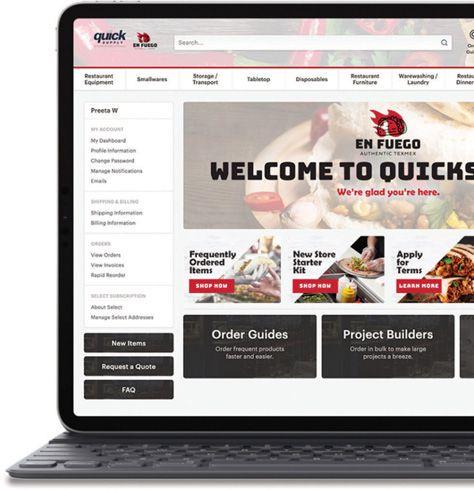
Menu additions and market expansions are standard practices for growing chain restaurants, and the QuickSupply site is equipped to facilitate these projects with only a few clicks. This ability allows the corporate team to save time and have complete visibility of the process, whether it’s a rollout to more than 1,000 stores at a time or a single new store opening package.
Your supply chain should never slow you down, and Clark National Accounts is here never to let it! RET
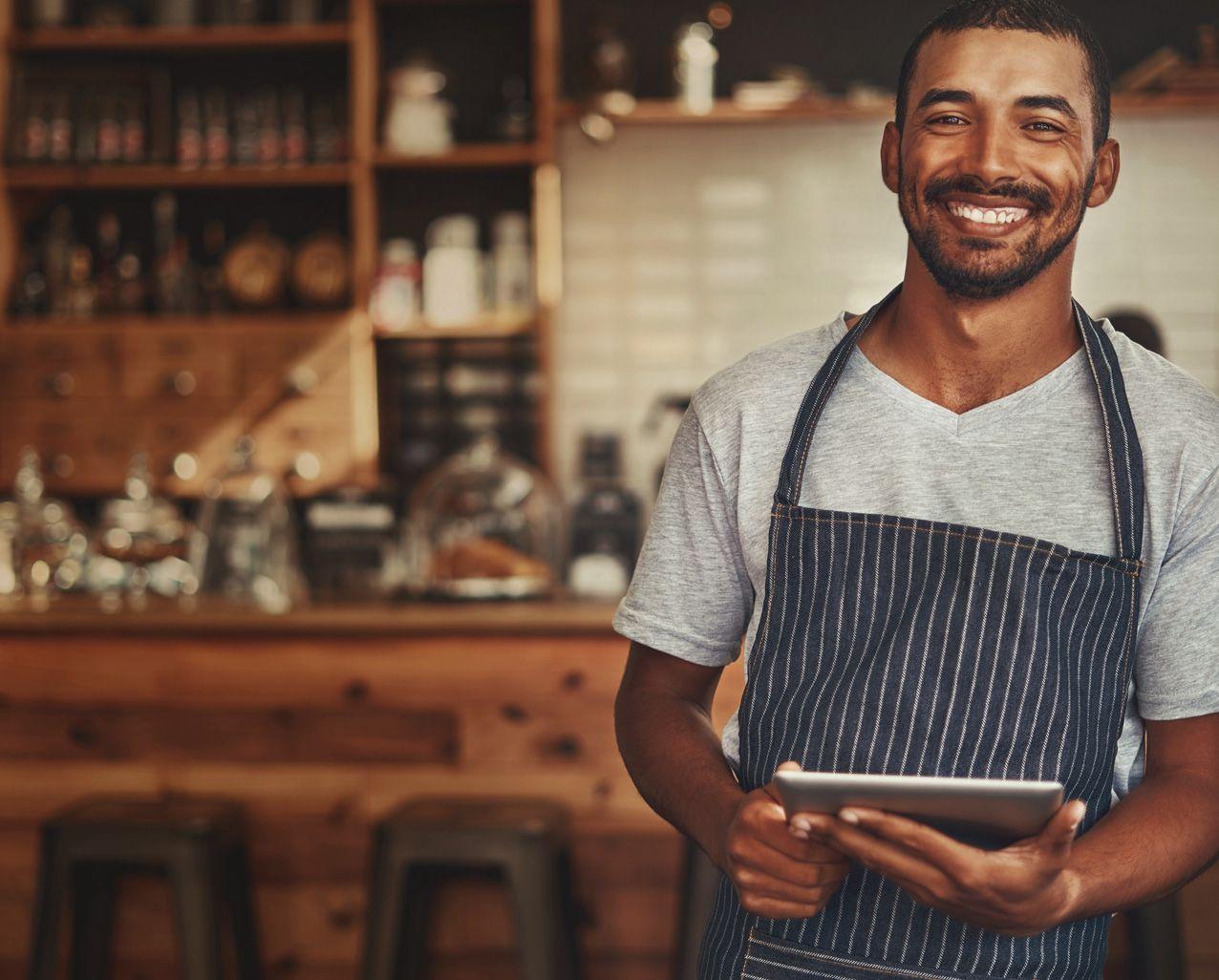





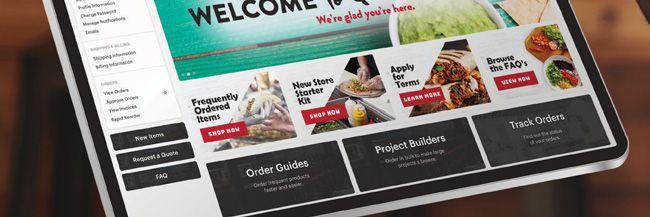






MENDOCINO FARMS, a 46-unit sandwich brand based in California, has seen increasingly strong sales over the past couple of years.

This sales growth has led to expansion for the brand, which plans to open 10-13 more stores in 2022. But expansion brings new challenges, says Brian Pearson, chief technology officer at Mendocino Farms. One of those challenges has been managing an ever-expanding network of store units and the associated pieces of equipment.
“As our volumes have increased, we’ve definitely seen opportunity in some of the original equipment we’ve purchased,” Pearson says. “Obviously, the volume is a good thing, but we need to make sure we add resilience to some of the processes and equipment to handle it. Being able to mine for that data is absolutely crucial.”
It’s why Pearson and the team at Mendocino Farms reached out to Ecotrak, an enterprise software startup founded by former restaurant operators and executives. Ecotrak creates seamless repairs and maintenance requests to a network of reliable vendors if and when equipment needs attention.
For example, if an oven malfunctions, the store manager creates a service request in a matter of seconds from a mobile app. That request initiates a brief troubleshooting process to make sure the issue needs professional attention. If and when it does, a technician is called to perform service and the system automatically creates an invoice.
But what Pearson and his team especially love about Ecotrak is the platform’s ability to help leverage analytics and guide datadriven decisions. These insights are part of Ecotrak’s lifecycle management system, wherein each piece of equipment is input into the platform and the software aggregates information like whether or not the equipment is still under warranty, or the maintenance it has received in the past.
“Prior to using Ecotrak, we were ‘guestimating’ the age of our equipment, using our gut instead of analytics,” says Gene Davis, senior director of facilities at Mendocino Farms. “Now we’re able to look at the age and the value of the equipment and that helps
us figure out if it should be repaired or replaced. It also helps in another way, where instead of having to repeatedly repair a piece of equipment for the same reason over and over, maybe you say, ‘Hey, look at what Ecotrak is telling us. This might not be the right piece of equipment for us.’”
Ecotrak has made Mendocino Farms more efficient at what it does best—serve great sandwiches to its loyal customers while expanding its footprint further and further—but it’s also made team members’ lives a whole lot easier, Pearson says.
“That’s such a huge part of this—there’s a quantitative ROI, and we believe this has already paid for itself in the six months or so since we implemented it,” Pearson says. “But there’s also a qualitative ROI—we’ve improved the quality of life of our employees, as well as ourselves. Ecotrak has given us a wealth of data and created invaluable change and helped scale our model for growth— it’s hard to put a price tag on that.” RET
For more on Ecotrak, visit ecotrak.com.
“Prior to using Ecotrak, we were ‘guestimating’ the age of our equipment, using our gut instead of analytics.”





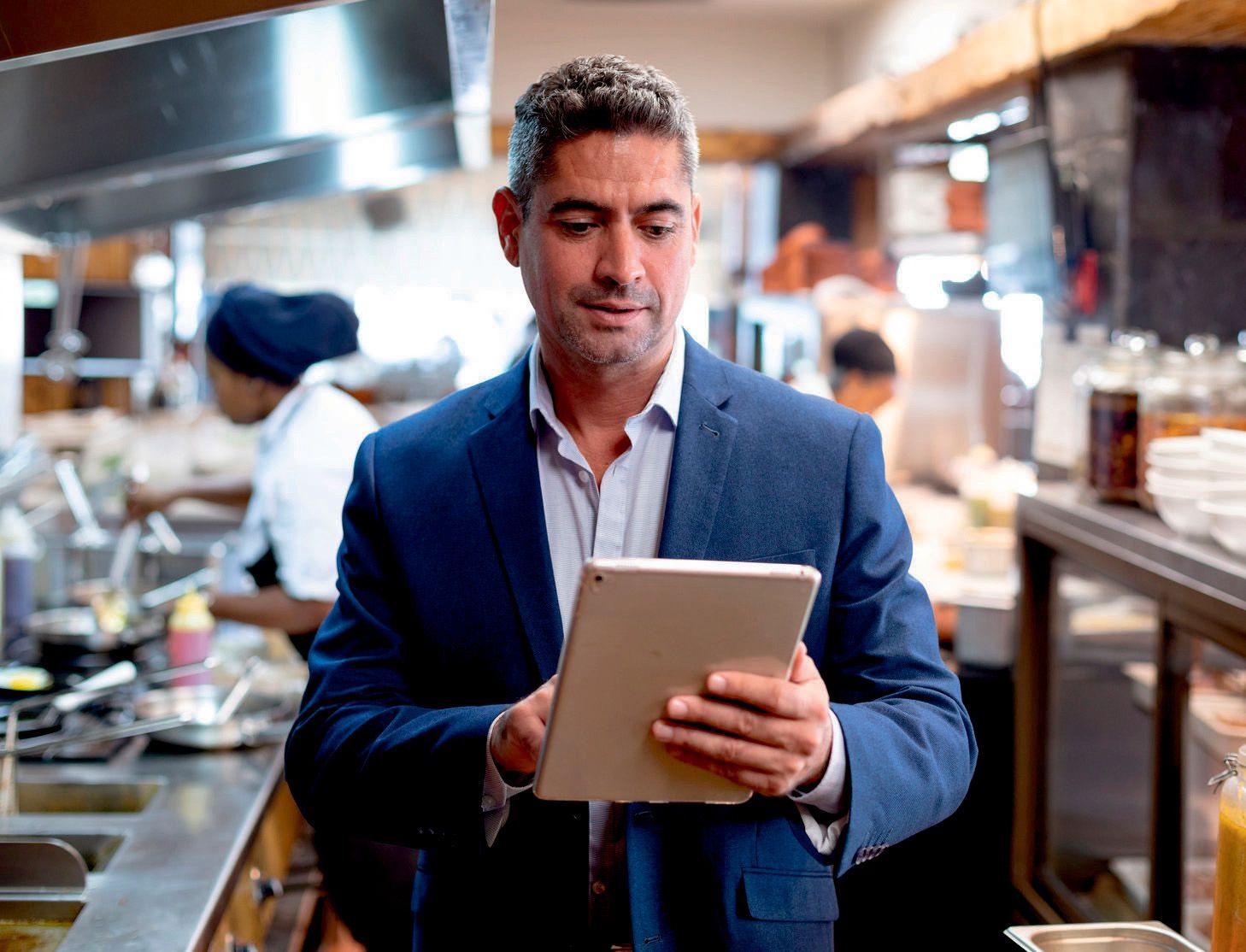
stored-hot-water systems,” Deivasigamani says. “These systems have stagnant water that promotes growth of harmful bacteria, like Legionella. Our systems don’t store water, and that alone eliminates those dangerous bacteria strains.”
WHILE THE RESTAURANT INDUSTRY was slow to adopt technology in many cases, the pandemic turned all of that on its head. Industry headlines have begun to detail how the future is here in many ways, as new tech platforms have been implemented to make restaurants more efficient at virtually everything they do. One area that may have largely been left out of that conversation is the hot water heater, where many restaurant brands are still using archaic technology to maintain a reliable hot water stream. Legacy water heaters are often massively inefficient. Consider that the U.S. Department of Energy reports that Americans waste two million Olympic-size swimming pools of water each year—and that’s just while they wait for water to warm up.
Cumbersome, inefficient machines aren’t the only way to do business, says Sridhar Deivasigamani, who is the founder and CEO of Intellihot, a company that builds tankless hot water heaters that are revolutionizing the way all types of businesses, including restaurants, obtain a reliable and steady supply of hot water. And what type of business needs a reliable and steady supply of hot water more than a restaurant?
“Ninety-nine percent of the market today uses gigantic,
Bacteria is just the beginning of the challenges that are solved by Intellihot’s tankless hot water heaters, which have won numerous awards for being best in class. First and foremost, Intellihot’s systems also help lower operating costs. The tankless water heater isn’t working when it doesn’t need to, so the system isn’t draining power trying to stay at a certain temperature when a restaurant is closed. In fact, the Intellihot iN199 Neuron can save restaurants up to 40 percent in energy costs.
The systems also cut back on needless pollution. In fact, since Intellihot was founded in 2009, the company’s units have logged 450 million hours of operation and have cut 6.6 billion pounds of CO 2 emissions—that means the tankless water heaters are a great way for restaurant brands to achieve their 2030 pledges aimed at decarbonization.
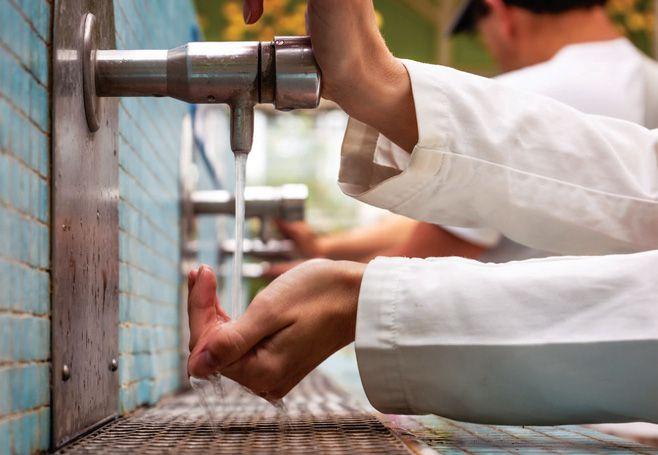
Finally, Intellihot’s suite of tankless water heater products use artificial intelligence to analyze their own performance, monitoring output and predicting when parts will need to be serviced or replaced. These metrics help turn water heating into yet another area where the restaurant industry is becoming increasingly efficient.
“Instead of worrying about the water systems and hoping they don’t quit at the worst possible moment, operators can relax knowing the Intellihot unit will inform them of any impending issues that could lead to a breakdown,” Deivasigamani says. “Preventive maintenance can be performed without any loss of service, all in an efficient, environmentally friendly package.” RET
For more on tankless water heaters, visit intellihot.com.
The solution is far more efficient than its predecessor.
The company’s units have logged 450 million hours of operation and have cut 6.6 billion pounds of CO2 emissions.




























Seasonal travel is heating back up. Here are some ways to be ready for a bigger in-person presence.

WITH SUMMER TRAVEL KICKING INTO FULL GEAR, many quick-service restaurants are feeling the strain on their labor resources more than ever before. Prior to the summer, some restaurants had already started reducing schedules and operating exclusively through drive-thru or pick-up services.
However, two years of pent up demand for traveling is now sending Americans across the country to catch up on their previously canceled plans. According to a survey by TripIt, from Concur, 73 percent of Americans plan to travel this summer, a 50 percent year-over-year increase. At the same time, the restaurant industry is still dealing with a historic lack of labor. This equals long lines, reduced menus, limited payment options, decreased customer satisfaction, and, ultimately, less revenue.
“This summer is going to be a real test for the restaurant industry,” says Lenny Evanseck, senior vice president of National Retail Business Development at Loomis. “Restaurants located in tourist destinations and around high-traffic travel locations like airports and hotels are going to be busier than ever. Leadership will need to manage the time of every operational task all while balancing employee retention and recruiting efforts.”
There are two main ways quick serves can minimize the impact summer travel and the labor shortage have on business: recruitment and retention efforts, as well as investing in automation. “There is a hugely competitive labor market right now,” says Evansek. “We are noticing that a lot of the same summer talent pool has opted for ‘gig’ jobs like driving for rideshare or third-party delivery companies. Also a strain on filling seasonal positions, the number of employed teenagers is at a level not seen since 1991 despite an increase of eligible employees in this demographic.”
Restaurants have to find a way to compete with the flexibility and higher pay often offered by the so-called gig economy. Beyond increased wages, restaurant operators looking for a competitive edge must deploy additional recruitment tactics such as support
for childcare, tuition reimbursement, healthcare for part-time workers, flex scheduling, and other incentives.
“While these tactics help, restaurants are still feeling a strain,” says Evansek. “This has led restaurant owners and operators to look at their overall operations and discover potential low-value tasks that can be automated.”
Through investing in automation, employees and managers can focus on guests and customer service while reducing time spent on back-store operations like cash handling, recruiting, onboarding, and scheduling. And when it comes to cash handling, Loomis’s Titan smart safe ecosystem reduces the time it takes employees and managers to perform mid-day drops and prepare deposits.
It also eliminates the need for managers to make trips to the bank, since cash is deposited into the safe, where it stays until Loomis’s armored car service picks it up. Best of all, even though cash is still physically on-premises within the safe, Loomis’s banking partners provide restaurants provisional credit for that cash waiting to be deposited. RET
To learn more, visit www.loomis.us/safepoint .



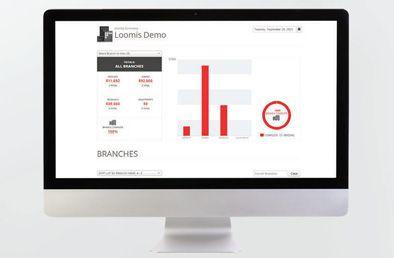












Digital menus are easily adjustable in real-time when an item is out of stock, additions to the menu are needed, or a timely, promotional message needs to be communicated.
additions to the menu are needed, or a timely, promotional message needs to be communicated. A static display would need to be reprinted and reposted, costing both time and money.
ACCORDING TO THE DELAGET 2020 QSR Operational Index, upwards of 82 percent of sales at a typical quick-service restaurant occurred at the drive thru, an increase from the previous year, which is likely to continue for the foreseeable future. With digital displays presenting a strong impact on the sales of quick-service restaurants, investing in high-quality, outdoor-rated displays for the drive-thru process is extremely important.

As quick serves make efforts to create an efficient ordering process, an important step has been utilizing digital menus as opposed to static menus. Given that visuals are so important, it’s valuable that digital menus are visually appealing, whereas, over time, static menus can become faded and dingy. Digital outdoor displays, in particular, are adaptable to be visible during times of harsh sunlight or after the sun has gone down completely, posing no disruption to customer orders. Additionally, digital menus are easily adjustable in real-time when an item is out of stock,
When choosing a digital menuboard, it is crucial to the reliability of the display that it is an outdoorrated device. An outdoor menuboard is subject to changes in weather and the effects of natural lighting, needing a dependable design to ensure legibility year-round. One of the ways to ensure an outdoor digital display is performing at its peak is to have an optically bonded screen. This screen can provide an easier visual experience and even reduce costs. While keeping natural light in mind, a good outdoor display should also be polarized to ensure any customers wearing sunglasses won’t have any issues viewing the screen. A built-in polarized film ensures the information gets across no matter the weather and can also make the ordering process more efficient for the customer and restaurant. Another central aspect of outdoor-rated displays is their Ingress Protection (ip) rating. Displays with an IP rating of 66 or higher will be waterproof and weatherproof against rain, snow, or other outdoor factors.
Choosing an esteemed manufacturer can also guarantee that these qualifications are met for a digital menuboard. A helpful service team can also provide a seamless installation so operations will not be disrupted.
While digital menuboards seem like a simple addition to quickservice operations, having a dependable, outdoor-rated display from a reputable manufacturer, can provide benefits to the customer experience as well as the success of quick-service sales and performance. RET




IT WAS ANOTHER TRYING YEAR IN THE INDUSTRY. While drive-thru traffic at most quick-service restaurants remained sky high, various other factors threw wrenches in what may have otherwise been a home run of a year for many brands—inflated prices, labor costs, as well as other looming side effects stemming from the pandemic created massive headaches across the industry.
With so many costs and expenditures out of their control, some operators began to invest in solutions that would offer some semblance of predictability. For example, repair plans offer an efficient and costeffective option to help ensure equipment is always up and running.
R.F. Technologies, Inc., a drive-thru headset repair company with five service centers across the country, has seen an increase in quick-service locations and franchisee groups using their repair programs for these very reasons. R.F. Technologies’ repair plans are customized to fit a restaurant brand or franchisee group’s needs and priced accordingly.
“Our repair programs provide customers peace of mind,” says Steve Symonanis, vice president of marketing with R.F. Technologies, Inc. “The programs offer customized coverage that fit the specific need for the number of locations and equipment you have.”
Another reason Symonanis believes interest in repair plans has gone up is due to the increased demand in the drive-thru space. That demand makes it more critical than ever to make sure equipment is up and running.

“Staffing is always an issue in the quick-service restaurant industry, but that’s especially true now,” Symonanis says. “You might have store owners or managers working the register or working on the grill. That really makes it difficult to train everyone on how to properly use and take care of the equipment, which, in turn, can cause an increase in needed repairs.”
Equipment repaired by R.F. Technologies, Inc. is completed and shipped back to the restaurant location in 24 hours of it being received at one of the company’s five locations. Operators needing equipment repairs—whether on a repair program or not—can go to the company’s website, rfdrivethru.com, to get a free shipping label to use to send in their damaged equipment. The labels are automatically addressed to the nearest R.F. Technologies, Inc. location to help provide for the fastest turnaround time.
“This is our core competency,” Symonanis says. “We understand that operators don’t have time to be waiting around for equipment—they need it yesterday. That’s how we conduct our business. We have been working with restaurant operators for over 30 years, acting as a lifeline for over 150,000 quick-service restaurants during that time.” RET
For more information, visit rfdrivethru.com.
How headset maintenance can become a controllable expense.
need for the number of locations and equipment you have.”


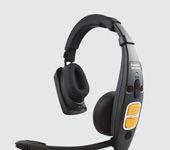















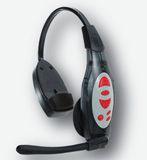
FACING RISING FOOD AND LABOR COSTS, franchisees are still expected to pay out the same royalties, marketing fees, and other fixed expenses. For these reasons, franchisees—and operators in general—are more focused than ever on finding places where top-line expenditures can be slashed.
One 20-unit franchisee group from a major restaurant chain—which wished to remain anonymous—recently installed an oil management system, Restaurant Technologies Total Oil Management solution, that is saving the brand $8,000 per year, per store in insurance expenses, reducing premiums by more than 20 percent from $769,447 to $612,838.
The system takes much or all of the risk out of handling cooking oil, which, according to a Restaurant Technologies study conducted by a major insurance provider, is responsible for approximately 60 percent of worker compensation claims in the quick-service space. For the franchisee group in question, installing the solution had become necessary. It wasn’t just about saving money—the Experience MOD stemming from worker compensation claims had increased from 1.32 to 1.62. The group knew it had to make a change, so leaders reached out to Restaurant Technologies.

Total Oil Management automates the entire process of handling cooking oil. Restaurant Technologies installs two oil tanks in the back of the restaurant, one for fresh oil and the other for waste oil. The fresh oil feeds directly into deep fryers at the push of a button, traveling through a secure tube to get there. When cooking oil is no longer fresh enough to create the quality fried foods operators and diners expect and exports the oil to the waste tank, a button is pressed, and the oil is seamlessly changed out. Notably, team members never have to lift large jugs of oil or handle oil that is hot and could cause burns.
“Safety is the number one reason to install Total Oil Management,” says David Eha, director of national accounts at Restaurant Technologies. “It’s just better and safer for you and your people. The fact that it will also help you save money—I mean, 20 percent on insurance goes right to the bottom line and is the cherry on top.”
Eha says the solution is perfect for any restaurant brand of any size that has deep fryers. The company is approved to sell into the stores of franchisees who own some of the top brands in the industry: McDonald’s, Burger King, and KFC to name just a few. On top of saving on insurance costs, franchisee groups and other restaurant groups appreciate the fact that Total Oil Management has become an employee retention tool. In other words, not only does it keep employees safer, but it keeps them happier, too. With the backdrop of today’s labor climate, that’s no small thing. RET
To learn more, visit RTI-Inc.com.
With top-line costs rising, practical cost-cutting measures are more pivotal than ever.SHUTTERSTOCK
LEARN MORE: WWW.RTI-INC.COM/INSURANCE-SAVINGS
LEARN MORE:
Risk is part of any business, especially prevalent in the foodservice industry. Restaurant Technologies’ solutions have reduced risk for our customers by simplifying the most dangerous jobs in commercial kitchens for nearly 25 years. From automating cooking oil handling to keeping your hood and flue protected from hazardous grease buildup, we’ve got you covered. Meanwhile, your employees stay safe, your worker’s comp and fire risk is reduced, and your insurance carrier stays happy.
Save up to 15% on your insurance premiums with Restaurant Technologies solutions.





Bluetooth probes that automatically populate HACCP logs. Solutions like BOHA! Temp connect your iOS devices to industry trusted temp probes for process that eliminates pencil-whipping and illegible handwriting all in one step.

KITCHENS ACROSS THE U.S. have experienced heightened food costs, labor shortages, and labor costs during 2022. So, what does this all mean for the back-of-house? Increased operational costs, lower customer satisfaction, and new challenges to be solved with by technology.
In a recent study conducted by the USDA, researchers found that the cost of food in April 2022 was 9.4 percent higher than the previous year. It’s predicted that the cost of food will increase at a higher rate than previous years. One way to combat this is by mitigating food waste.
Over 85 percent of food loss and food waste issues are caused by temperature and time. By using remote temperature sensors, operators can be notified of real-time temperature changes before any food spoils or becomes unusable. This is especially important with cold storage products, such as meat or dairy, where you have a maximum of two hours to remedy an “out-of-range” temperature before that food must be disposed of.
Kitchen staff can also digitize food temp taking by utilizing
Labor shortages were an industry concern long before the pandemic. However, a whopping seven out of 10 food service operators reported difficulty meeting labor demands in a 2022 report released by the National Restaurant Association. Not only is it difficult for operators to find and hire new staff, it’s also difficult to train them efficiently and retain them indefinitely.
One of the ways that operators have had newfound success in training employees is by digitizing recipe cards, instructional videos, how-to sheets, and other important resources. By using cloudbased solutions like BOHA! Media, employees across the globe can instantly access important resources right in the kitchen when they need them most. And another bonus, this also eliminates pricey reprints of recipe cards any time they get damaged or a recipe changes. All changes can be made from the cloud and pushed to dozens of locations in a matter of minutes.
By using back-of-house technology, operators in the foodservice industry have seen a significant reduction in the time it takes for employees to complete necessary tasks. For example, in a case study by BOHA!, implementing back-of-house technology saved retailers three hours a week on task management by digitizing checklists. In addition, when using BOHA! Labeling to automate date code processes, operators saw an average of 4.8 hours saved per week per location. When employees are so hard to come by, every minute counts. RET
To learn more, visit bohasolutions.com.


Ditch the masking tape, paper, and pencils for a solution operators, franchisees,

• Slash labor costs
• Improve accountability
• Prevent unnecessary food waste
• Enhance Food Safety & Quality
Across ALL locations — from the cloud
UPM Raflatac OptiCut Direct Thermal Linerless label materials enable hospitality businesses to respond to trends in more sustainable packaging.

FOR QUICK-SERVICE RESTAURANTS, efficiency and order accuracy are key to business success. Due to the pandemic, consumers now have heightened expectations of the to-go experience. This means the performance of labels securing accuracy is more important than ever.
As well, consumers, governments, and the industry have increased their expectations of hospitality companies’ environmental impact. This means companies must take tangible actions to transition to sustainable use of materials and reduce waste.
OptiCut Direct Thermal (dt) Linerless labels from UPM Raflatac enable hospitality businesses to respond to these trends.
OptiCut products are designed to improve process efficiency and order accuracy. They offer print clarity and low adhesive build-up in your liner-free printer. Additionally, UPM Raflatac developed OptiCut to stick, peel, and re-label on different substrates. This includes many packaging types available to restaurants. Finally, OptiCut labels perform in various conditions, like hot, humid, and moist environments.
“We developed OptiCut to meet needs of companies that use a variety of packaging types in a fast-paced hospitality environment,” says Brinder Gill, sales director at UPM Raflatac Americas. “We recognized the need for a linerless solution where the adhesive will not jam up the liner-free printer, and the label will perform in diverse environments.”
OptiCut products offer many improvements over standard DT linerless labels. They increase efficiency because the material causes less adhesive build-up on the printer’s cutting knife. This reduces printer jams, improves printability, and extends the printer’s service cycle.
The performance of OptiCut has been tested with many printers. For example, Epson has qualified OptiCut Linerless products on its new OmniLink TM-L100 liner-free compatible thermal label printer.
“Our partnership with Epson will allow more end-users to benefit from the efficiencies, high performance, and sustainable design of our OptiCut products,” Gill says.
For anyone switching from linered DT labels, the sustainability impact is significant. Using linerless brings up to a 40 percent reduction in material usage compared to traditional DT labels, which means significant carbon reduction. Now, companies using OptiCut materials can obtain reliable calculations verified by the Carbon Trust showing their reduction in carbon footprint compared to linered DT label alternatives.
Moreover, OptiCut materials carry the CarbonNeutral certification by Natural Capital Partners. We have compensated for the Linerless range’s cradle-to-customer unavoidable greenhouse gas emissions through projects that reduce or avoid carbon emissions.
Regardless of the size of your business, UPM Raflatac can support your transition to linerless. “There is no comparison in our linerless capacity, which exceeds 100 million meters,” Gill says. “We support our customers through a global distribution network, enabling them to transition to DT linerless solutions smoothly and at their pace.” RET
Benefit from DT Linerless with superior adhesive performance and repositionability on a wide range of packaging, and reduce downtime of your liner-free printer thanks to less adhesive accumulation. The OptiCut™ Linerless experience is waiting.


can help facilitate this by keeping menus current and guiding customers to online ordering and menus via a QR code.
Supply chain shortages: A survey by the National Restaurant Association showed that 96 percent of restaurant operators experienced supply delays or shortages last fall, and that has become a bigger issue this year. Digital reader boards help restaurants advertise menu items that are in stock, quickly change menus when shortages occur, and guide customers to limited-time offers and higher profit margin items.
Fewer tables for in-person dining: Many restaurants are continuing to promote social distancing by offering fewer tables for in-person dining. During busy times, digital reader boards can encourage the use of drive thrus to prevent over-crowding inside the restaurant.
THE QUICK-SERVICE RESTAURANT INDUSTRY was one of the few that weathered the pandemic and came out stronger. According to the NPD Group, a marketing research firm, 70 percent of all dollars spent eating out in the year ending March 2021 were at quick-service restaurants.
One reason is that quick-service brands were able to continue operating drive thrus during the pandemic even when their dining rooms closed. Yet the secret ingredient was their use of digital reader boards to keep customers apprised in real time as operations changed.
Now that we are in a post-pandemic phase of COVID-19, digital reader boards will play an even bigger role in helping quick-service restaurants succeed in a changing environment. Here are some of the top trends we are seeing and how digital reader boards can help restaurants keep customers informed:
Contactless ordering: A recent report showed that 60 percent of quick-service customers now prefer to place their orders online or using a kiosk instead of ordering through a staff member. Digital reader boards located outside and inside a restaurant
Labor shortages: Like most businesses, quick-service brands are struggling to hire enough workers. Digital reader boards can be effective in communicating current open positions, starting pay, and benefits that set restaurants apart from their competitors. They also can promote QR codes or websites for online applications.
Community support: As valuable community members, restaurants are known for their support of local causes. Digital reader boards allow quick-service brands to demonstrate their community involvement by promoting local events and highlighting charitable efforts. For example, DQ uses digital reader boards to highlight its involvement with Children’s Miracle Network by elevating Miracle Treat Day.

Finally, customer loyalty continues to play an important role in the success of quick-service restaurants. Digital reader boards help build loyalty by allowing managers to rapidly communicate updates to customers. From item shortages to drive-thru-only service, things can change quickly. Digital reader boards help manage customer expectations and keep loyal fans. RET
To learn more, visit watchfiresigns.com.
A recent study found that 34% of shoppers associate sign quality with store and product quality. Is an outdated plastic letter reader board meeting your standards for quality and customer impact?
Engage your customers with brand-approved dynamic messaging. Program your QSR’s advertising content months in advance or make last minute changes. Cloud-based management software lets you make updates from anywhere with an internet connection and control one sign or a network of screens.
Are you still entrusting your QSR brand to an employee with a box of plastic letters and a changing pole? Showcase your branded products messages and drive sales with clear, vibrant Watchfire digital reader boards.
Contact Watchfire Signs today for your indoor and outdoor digital signage needs.

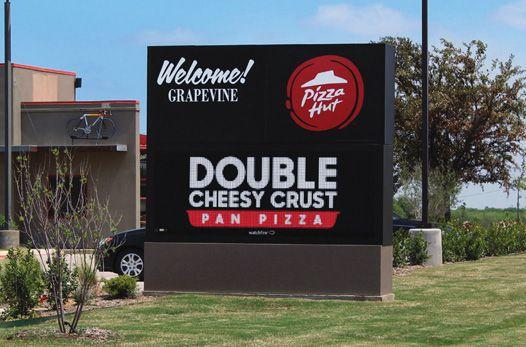
800-637-2645 | watchfiresigns.com

WITH EVER-EVOLVING OPERATIONAL CHALLENGES, it’s never been more important to ensure every kitchen benefits from the latest techled solutions. With the right technology in place, brands can manage numerous mounting pressures, from cost increases and staff shortages to supply constraints.
Welbilt’s KitchenConnect is an open-cloud solution which is supported by the largest ecosystem in the foodservice industrycombining strength in numbers with industry-leading expertise. Before meeting the key players in the KitchenConnect ecosystem, explore why Welbilt has the edge in this space.
The foodservice industry is in the midst of the largest digital transformation in history – and Welbilt was first to recognize a need to evolve beyond the common controllers included with traditional equipment. Ease-of-use is an important factor in design and drives efficiency, however harnessing equipment which is connected drives more efficiency while reducing resources. This is critical as staff can focus on what is most important – the customer experience.
Welbilt’s Born Digital strategy helped cultivate products that were plug-and-play for connectivity. Keeping that model in mind, connecting beyond equipment became central to maximizing a kitchen’s efficiency.
Enter: KitchenConnect, the only culinary focused platform that can be remotely monitored, controlled, and adapted to a brand’s kitchen. It reduces operational costs, increases equipment uptime, and enhances food safety. KitchenConnect’s ecosystem is powered by the biggest digital companies in the Internet of Things (iot) space that will empower Welbilt’s homegrown cloud platform to deliver the ultimate connected restaurant environment for brands.
AT&T provides a global cellular service complete with a professional service team for restaurant connectivity set up. Its SmartHub edge connects all equipment in the restaurant to KitchenConnect. Next up, Bruviti serves an AI-powered customerservice triage and parts-prediction platform for KitchenConnect that delivers superior aftermarket service so operators have the
peace of mind and time to focus on the customer.
Best-in-class digital transformation expertise is provided by HCL to integrate end-to-end technologies including cloud, IoT, AI, analytics, and cybersecurity on Welbilt’s unique platform. Microsoft delivers secure edge infrastructure with Azure Sphere and hosts KitchenConnect on the Azure IoT platform for critical insights into kitchen operations.

To fine-tune operations, KitchenConnect is enhanced by Perfect Company to deliver a best-in-class Kitchen Crew Operating System
which eliminates food waste, decreases training time, and increases food quality and speed of service. Last but not least, TeamViewer offers a cutting-edge solution for remote service and augmented reality for KitchenConnect products. This unique technology can help reduce training time, simplify repairs, and help self-diagnose issues as they come available for both repairers or kitchen operators—all designed to help increase uptime of equipment.
Working seamlessly together to power KitchenConnect, these best-in-class technology companies deliver complementary and much-needed digital solutions to brands at the highest standard. RET

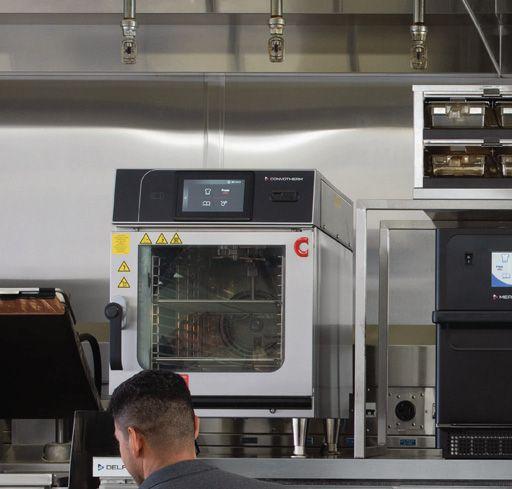









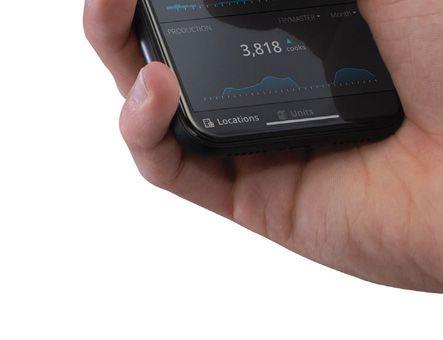









Operators report a return on investment in as little as nine months after installing this solution.
THE DRIVE THRU HAS LONG BEEN the lifeblood of the quick-service industry, but the pandemic helped refocus the attention of consumers and operators alike on the importance of an efficient drive-thru operation. Anything that helps speed up transactions, increase order accuracy, and help brands better serve their customers has mutual benefit to quick-service brands and their loyal followers.
Xenial (pronounced zee-nee-ul) is a single technology platform that offers “end-to-end, enterprise-ready restaurant solutions, customer engagement tools, and global reach,” says Tracy Gallimore, vice president of sales with Xenial.
“While others have been talking about the ‘drive-thru of the future,’ we’ve been building it,” Gallimore says. “Xenial NextGen Drive-Thru gives you full visibility into your growing drive-thru channel, along with an integrated set of tools to drive sales. It’s all powered by our patent-pending NextGen Drive-Thru Controller, which can give brands a return on investment in as little as nine months.”
According to Gallimore, here’s how Xenial’s Next-Gen Drive-Thru Controller can help increase velocity and sales within a drive thru.

The system helps capture speed of service metrics in any facet of an operation’s drive thru with a timer system that is powered by cameras and artificial intelligence (ai). Xenial’s clients reduce drive-thru times by about 12 seconds or more when leveraging the company’s technology.
Brands can manage rising labor costs and address labor shortages with the system’s voice assistant (“bot”)-driven ordering and self-service kiosks, helping replace labor once done by employees.
Restaurants enjoy an increase in average check size using AI-driven automated upselling, along with bright, engaging
displays that connect the brand to consumers. Xenial’s clients report a 2.5 percent boost in overall sales and 2 percent increase in both LTO and combo-meal upsells.
The payment process can be simplified and sped up by using QR codes that help drive the customer to an online payment platform.
Xenial’s Next-Gen Drive-Thru Controller helps unite an ecosystem of products under its platform, including AI-enabled
voice ordering, a recommendation engine, and camera-based timer, along with ports for drive-thru hardware such as base station, mic, speaker, and OCU.
“With over 30 years of experience, Xenial has a direct presence in 62 countries, serving 51,000 locations and another 110,000 cloud merchants, including 20 of the top 50 quick-service brands in the U.S.,” Gallimore says. “Our namesake comes from the Greek word for hospitality and that’s a reference to our obsession to power your enterprise’s hospitality success. We would love to connect with your brand and help introduce our solution for the future of the drive thru.” RET
For more information, visit xenial.com or call 855-936-4251.
“While others have been talking about the ‘drive-thru of the future,’ we’ve been building it.”

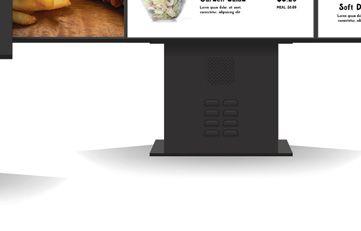
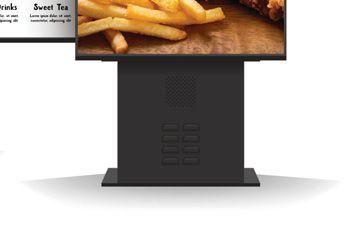


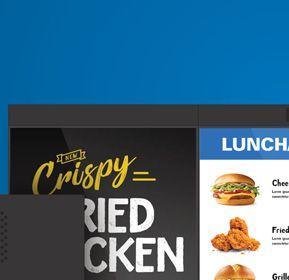

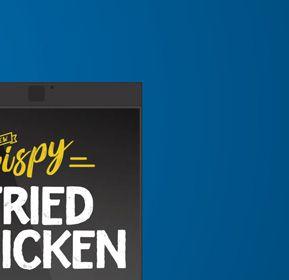












For more information on these companies, visit www.QSRmagazine.com/connect/
Bevolutio n ............................. Inside Back 888-466-9941 | drsmoothie.com
BidVita ..................................................8 Bidvita.ai
Bonchon Franchise ..................Back Cover Bonchon.com
California Milk Advisory Board ...........6, 7 209-883-6455 | realcaliforniamilk.com
Fuzzy’s Taco Shop ................................26 817-624-8226 x2 | myfuzzys.com
Ghirardelli ............................Inside Front 800-877-9338 | ghirardelli.com
HME .....................................................23 866-577-6721 | hme.com/nexeo
Jersey Mike’s ........................................17 jerseymikes.com

Jimmy John’s ........................................3 jimmyjohnsfranchising.com
Juang Jia Guoo Company .....................45 JJGPAPERBAG.com
McBride ..........................................14, 15 423-429-1107 | mcbride-re.com
NorthAmerican Bancard ......................41 866-481-4604 | NYNAB.com | tryerc.com
Quail Digital ........................................35 888-575-1010 | quaildigital.com
RF Technologies ..............................5, 80 800-598-2370 | rfdrivethru.com


Robot Coupe .......................................25 robot-coupe.com
S-Net .................................................80 844-986-1949 | qsr.snetconnect.com

Simplot ...............................................13 Simplotfoods.com
TriTech ................................................31 336-358-6151 | tri-techservices.com
Vitality Bowls ......................................33 www.vitalitybowls.com
Vitamix ...............................................19 vitamix.com/ourdifference
Vito Fryfilter ........................................39 847-859-0398 | vitofryfilter.com
Worcester ..........................................44 800-533-5711 | Shortening-Shuttle.com
RESTAURANT EQUIPMENT & TECHNOLOGY .......47-79
Acrelec ........................................48-49 acrelec.co/double-check
Apex ............................................50-51 ApexOrderPickup.com | MercoProducts.com
Botrista ........................................52-53 botrista.io
ChargeNet ...................................54-55 chargenetstations.com
Clark National Accounts ................56-57 Clarknationalaccounts.com
EcoTrak ........................................58-59 888-219-0000 | ecotrak.com/qsr

Intellihot .....................................60-61 866-447-0209 | intellihot.com

Loomis ........................................62-63 713-435-6700 opt. 2 | loomis.us
Peerless ......................................64-65 peerless-av.com
RF Technologies ..........................66-67 800-598-2370 | rfdrivethru.com

Restaurant Technologies .............68-69 RTI-inc.com/insurance-savings
Transact Tech ................................70-71 877-748-4222 | transact-tech.com/qsr-mag
UPMRAFLATAC ..............................72-73 go.upmraflatac.com/OptiCutLinerless
Watchfire .....................................74-75 800-637-2645 | watchfiresigns.com



Welbilt .........................................76-77 877-375-9300 www.welbilt.com/KitchenConnect/About
Xenial ...........................................78-79 855-936-4251 | xenial.com/solutions/drive-thru


















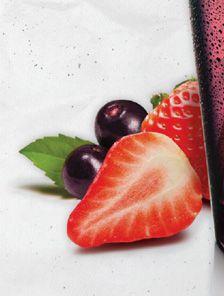











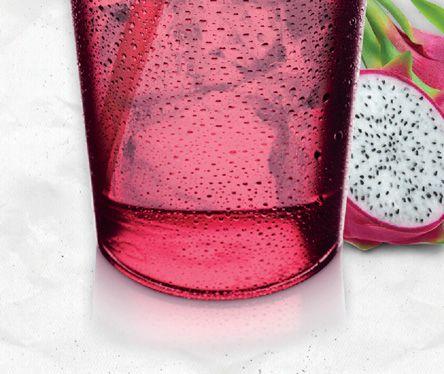


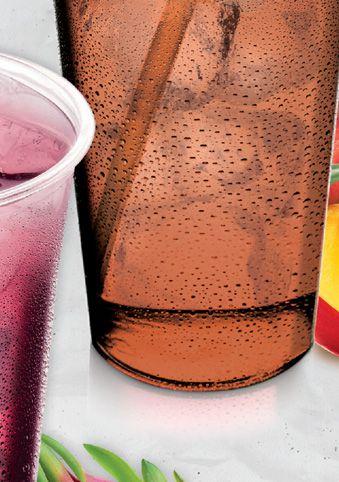

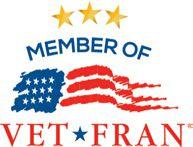
*Figure reflects the average annual Gross Revenues for 100 franchised Bonchon restaurants in the system that were open during the measured period from January 1, 2021 through December 31, 2021, as published in Item 19 of our March 4, 2022 (amended March 9, 2022) Franchise Disclosure Document. Of these 100 franchised Bonchon restaurants, 42 (42%) had higher Gross Revenues during the reported period. The financial performance representation contained in Item 19 of our March 4, 2022 (amended March 9, 2022) Franchise Disclosure Document also includes the average and median annual Gross Revenues information for these 100 franchised Bonchon Restaurants in operation in the United States during the referenced period. A new franchisee’s results may differ from the represented performance. There is no assurance that you will do as well, and you must accept that risk. **As of 12/25/21. ***5 year growth rate in number of units for the year ended December 31, 2021.






NOTICE: This advertisement is not
only be made a prospectus first filed with the Department of Law of the State of New York. Such filing does not constitute approval by the Department of Law. CALIFORNIA REQUIRED NOTICE: These franchises have been registered under the Franchise Investment Law of the State of California. Such registration does not constitute approval, recommendation or endorsement by the Commissioner of Business Oversight that the information provided herein is true, complete and not misleading.